Grace Elliot's Blog: 'Familiar Felines.' , page 12
March 26, 2014
King James I - Dogs, Hunting and the Nation's Discontent
Much has been written about the English Civil War and ordinary people rising up against the monarchy. King Charles I believed in his divine right to rule and his unilateral power to set religious practices for his kingdom. But it is Charles’ father, King James I who is the subject of today’s blog post. The reason? James’ attitude to dogs and hunting shows how out of touch the monarch was with his subjects and how the seeds of rebellion were sown.
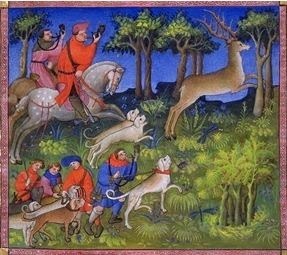 Medieval hunts were confined to royal estates or private landPrior to James I hunting was a well regulated pastime. The hunt took place in a royal park or on land owned by a nobleman. The huntsmen stood on wooden platforms or ‘pavilions’ and beaters forced animals forced through a narrow channel for hunters to shoot. Whatever the ethics of this activity the effect on local farming was minimal and the nobleman who arranged the hunt bore the expense.However, with James I’s accession to the throne all this changed.
Medieval hunts were confined to royal estates or private landPrior to James I hunting was a well regulated pastime. The hunt took place in a royal park or on land owned by a nobleman. The huntsmen stood on wooden platforms or ‘pavilions’ and beaters forced animals forced through a narrow channel for hunters to shoot. Whatever the ethics of this activity the effect on local farming was minimal and the nobleman who arranged the hunt bore the expense.However, with James I’s accession to the throne all this changed.
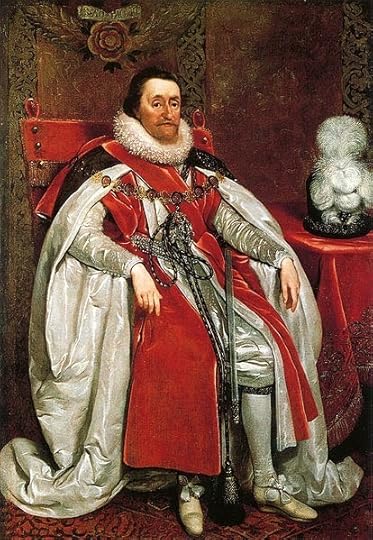 King James I- physically unprepossessing he liked
King James I- physically unprepossessing he liked
the presence that being in the saddle gave him.James asserted, as William the Conqueror had, “a royal prerogative” to hunt. To this end it was expected all the subjects of his realm, from noblemen to peasants, would facilitate this sport. In practice this meant he was free to roam across any land he wished – and do tremendous damage in the process.James wanted to hunt in the French style – which involved mounted huntsmen tearing across the countryside on horses. To this end he imported French hounds and fifty red deer from a forest in Fontainebleau. James’ detractors went so far as to say he spent his life in the saddle and in common with many country squires, hunting was all he seemed to care about.“Does all go well with you? In all your letters I find not one word of horse, hawk or hound?”Letter to James I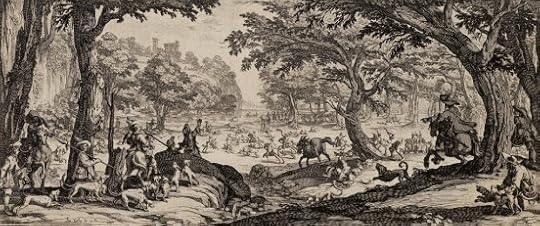 The royal hunt was allowed to ride over any land it desired.In keeping with the French way of hunting with James placing restrictions on land owners and farmers. If the hunt was to pass their way he forbade the ploughing of land (furrows being a hazard to galloping horses) and ordered pigs to be confined (so their rooting didn’t create dangerous holes) Worse still, locals were commanded to take down any fences, walls or hedges that might obstruct His Majesty’s ride.During the hunt itself mounted huntsmen and packs of hounds caused considerable damage – often trampling crops, damaging fences, destroying gardens and scattering flocks or herds of animals. But the disruption didn’t end there. Local common folk were ordered to provide workers to assist the hunt, taking them away from their work – if it was harvest time.
The royal hunt was allowed to ride over any land it desired.In keeping with the French way of hunting with James placing restrictions on land owners and farmers. If the hunt was to pass their way he forbade the ploughing of land (furrows being a hazard to galloping horses) and ordered pigs to be confined (so their rooting didn’t create dangerous holes) Worse still, locals were commanded to take down any fences, walls or hedges that might obstruct His Majesty’s ride.During the hunt itself mounted huntsmen and packs of hounds caused considerable damage – often trampling crops, damaging fences, destroying gardens and scattering flocks or herds of animals. But the disruption didn’t end there. Local common folk were ordered to provide workers to assist the hunt, taking them away from their work – if it was harvest time.
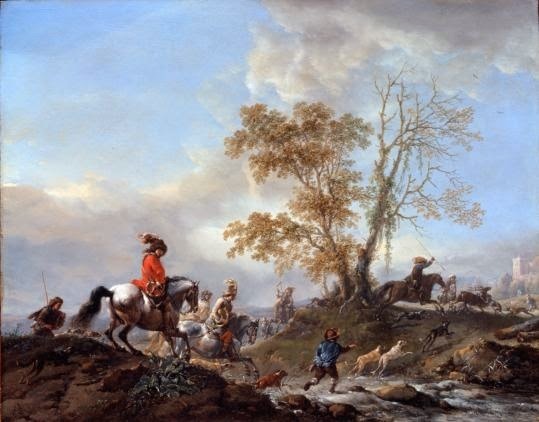 No thought was given to the damage to crops, livestock or landIn addition, a farmer was expected to provide food and fodder for all the royal party – which could easily amount to a hundred or so people. Attempts to appeal to the king to recoup their expenses fell on deaf ears. Indeed, during one hunt, a local hit on an ingenious way of getting the king’s attention – by kidnapping his favorite dog, Jowler.Jowler went missing and reappeared later with a message tied to his collar which read:“Good Mr Jowler, we pray you speak to the King, for he hears you every day, and he does not hear us. Ask that His Majesty be pleased to go back to London, or else this countryside will be undone. All our provisions are used up already and we are not able to entertain him any longer.”Instead of taking note, James laughed the matter off and carried on hunting.
No thought was given to the damage to crops, livestock or landIn addition, a farmer was expected to provide food and fodder for all the royal party – which could easily amount to a hundred or so people. Attempts to appeal to the king to recoup their expenses fell on deaf ears. Indeed, during one hunt, a local hit on an ingenious way of getting the king’s attention – by kidnapping his favorite dog, Jowler.Jowler went missing and reappeared later with a message tied to his collar which read:“Good Mr Jowler, we pray you speak to the King, for he hears you every day, and he does not hear us. Ask that His Majesty be pleased to go back to London, or else this countryside will be undone. All our provisions are used up already and we are not able to entertain him any longer.”Instead of taking note, James laughed the matter off and carried on hunting.
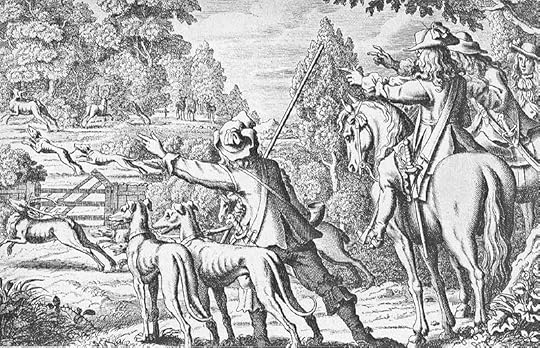 Farmers were expected to give the royal hunt free access to fields -
Farmers were expected to give the royal hunt free access to fields -
and might have his own dogs confiscated by way of thanks.To add insult, the manner in which James acquired his hounds also caused distress. In 1616 he commissioned Henry Mynours, Master of the Otterhounds, to:“Take for us and in our name [The King] in all places within this realm of England…such and so many hounds, beagles, spaniels and mongrels, as well as dogs and bitches fit for hunting the otter as the said Henry Mynours shall think fit.”For an animal loving nation this was a step too far – especially as James seized some pet dogs to take part in another ‘sport’ he supported – bull and bear-baiting. To ensure there was no argument James appointed Edward Alleyn as “Chief master, ruler and overseer of all and singular games, of bears and bulls and mastiff dogs and mastiff bitches”. This gave Alleyn unlimited authority to seize whatever dogs he saw fit in order to send them into the ring.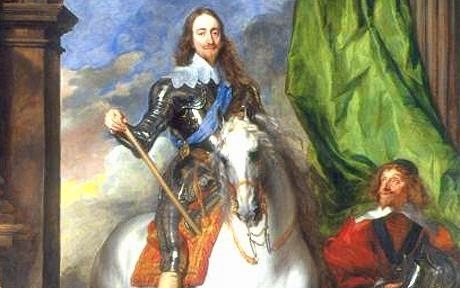 Charles I - son of James I - following in his father's footstepsPeople began to rebel. The officials whose job it was to enforce the dog levies, were increasingly opposed, some were even attacked and beaten. The local magistrates who were supposed to sentence the offenders, refused to put them on trial – the common man had had enough.Another faction started to voice their discontent – that of the Puritans. They believed hunting was a sin. They referred James to the Old Testament and how God condemned King Nimrod – described as a mighty hunter. The Puritans argued that animals were provided by God for sustenance and to improve the world, and not to be treated cruelly and abused. As a concession to public pressure, James prohibited animal baiting on Sundays – but nothing else changed.
Charles I - son of James I - following in his father's footstepsPeople began to rebel. The officials whose job it was to enforce the dog levies, were increasingly opposed, some were even attacked and beaten. The local magistrates who were supposed to sentence the offenders, refused to put them on trial – the common man had had enough.Another faction started to voice their discontent – that of the Puritans. They believed hunting was a sin. They referred James to the Old Testament and how God condemned King Nimrod – described as a mighty hunter. The Puritans argued that animals were provided by God for sustenance and to improve the world, and not to be treated cruelly and abused. As a concession to public pressure, James prohibited animal baiting on Sundays – but nothing else changed.
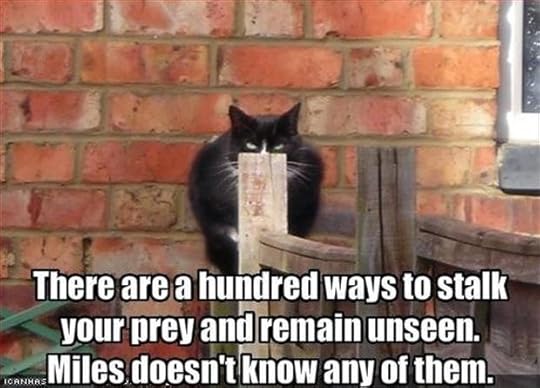
This brings us to Charles I and the English Civil War. When James I died and his son, Charles, acceded to the throne, just as his father before him Charles was inflexible when it came to matters of popular opinion. He believed in his divine right to rule as he saw fit and upheld unpopular policies such as dog confiscation that went to fuel the nation’s negative feelings and resentment toward the monarchy…
 Medieval hunts were confined to royal estates or private landPrior to James I hunting was a well regulated pastime. The hunt took place in a royal park or on land owned by a nobleman. The huntsmen stood on wooden platforms or ‘pavilions’ and beaters forced animals forced through a narrow channel for hunters to shoot. Whatever the ethics of this activity the effect on local farming was minimal and the nobleman who arranged the hunt bore the expense.However, with James I’s accession to the throne all this changed.
Medieval hunts were confined to royal estates or private landPrior to James I hunting was a well regulated pastime. The hunt took place in a royal park or on land owned by a nobleman. The huntsmen stood on wooden platforms or ‘pavilions’ and beaters forced animals forced through a narrow channel for hunters to shoot. Whatever the ethics of this activity the effect on local farming was minimal and the nobleman who arranged the hunt bore the expense.However, with James I’s accession to the throne all this changed.
 King James I- physically unprepossessing he liked
King James I- physically unprepossessing he likedthe presence that being in the saddle gave him.James asserted, as William the Conqueror had, “a royal prerogative” to hunt. To this end it was expected all the subjects of his realm, from noblemen to peasants, would facilitate this sport. In practice this meant he was free to roam across any land he wished – and do tremendous damage in the process.James wanted to hunt in the French style – which involved mounted huntsmen tearing across the countryside on horses. To this end he imported French hounds and fifty red deer from a forest in Fontainebleau. James’ detractors went so far as to say he spent his life in the saddle and in common with many country squires, hunting was all he seemed to care about.“Does all go well with you? In all your letters I find not one word of horse, hawk or hound?”Letter to James I
 The royal hunt was allowed to ride over any land it desired.In keeping with the French way of hunting with James placing restrictions on land owners and farmers. If the hunt was to pass their way he forbade the ploughing of land (furrows being a hazard to galloping horses) and ordered pigs to be confined (so their rooting didn’t create dangerous holes) Worse still, locals were commanded to take down any fences, walls or hedges that might obstruct His Majesty’s ride.During the hunt itself mounted huntsmen and packs of hounds caused considerable damage – often trampling crops, damaging fences, destroying gardens and scattering flocks or herds of animals. But the disruption didn’t end there. Local common folk were ordered to provide workers to assist the hunt, taking them away from their work – if it was harvest time.
The royal hunt was allowed to ride over any land it desired.In keeping with the French way of hunting with James placing restrictions on land owners and farmers. If the hunt was to pass their way he forbade the ploughing of land (furrows being a hazard to galloping horses) and ordered pigs to be confined (so their rooting didn’t create dangerous holes) Worse still, locals were commanded to take down any fences, walls or hedges that might obstruct His Majesty’s ride.During the hunt itself mounted huntsmen and packs of hounds caused considerable damage – often trampling crops, damaging fences, destroying gardens and scattering flocks or herds of animals. But the disruption didn’t end there. Local common folk were ordered to provide workers to assist the hunt, taking them away from their work – if it was harvest time.
 No thought was given to the damage to crops, livestock or landIn addition, a farmer was expected to provide food and fodder for all the royal party – which could easily amount to a hundred or so people. Attempts to appeal to the king to recoup their expenses fell on deaf ears. Indeed, during one hunt, a local hit on an ingenious way of getting the king’s attention – by kidnapping his favorite dog, Jowler.Jowler went missing and reappeared later with a message tied to his collar which read:“Good Mr Jowler, we pray you speak to the King, for he hears you every day, and he does not hear us. Ask that His Majesty be pleased to go back to London, or else this countryside will be undone. All our provisions are used up already and we are not able to entertain him any longer.”Instead of taking note, James laughed the matter off and carried on hunting.
No thought was given to the damage to crops, livestock or landIn addition, a farmer was expected to provide food and fodder for all the royal party – which could easily amount to a hundred or so people. Attempts to appeal to the king to recoup their expenses fell on deaf ears. Indeed, during one hunt, a local hit on an ingenious way of getting the king’s attention – by kidnapping his favorite dog, Jowler.Jowler went missing and reappeared later with a message tied to his collar which read:“Good Mr Jowler, we pray you speak to the King, for he hears you every day, and he does not hear us. Ask that His Majesty be pleased to go back to London, or else this countryside will be undone. All our provisions are used up already and we are not able to entertain him any longer.”Instead of taking note, James laughed the matter off and carried on hunting.
 Farmers were expected to give the royal hunt free access to fields -
Farmers were expected to give the royal hunt free access to fields -and might have his own dogs confiscated by way of thanks.To add insult, the manner in which James acquired his hounds also caused distress. In 1616 he commissioned Henry Mynours, Master of the Otterhounds, to:“Take for us and in our name [The King] in all places within this realm of England…such and so many hounds, beagles, spaniels and mongrels, as well as dogs and bitches fit for hunting the otter as the said Henry Mynours shall think fit.”For an animal loving nation this was a step too far – especially as James seized some pet dogs to take part in another ‘sport’ he supported – bull and bear-baiting. To ensure there was no argument James appointed Edward Alleyn as “Chief master, ruler and overseer of all and singular games, of bears and bulls and mastiff dogs and mastiff bitches”. This gave Alleyn unlimited authority to seize whatever dogs he saw fit in order to send them into the ring.
 Charles I - son of James I - following in his father's footstepsPeople began to rebel. The officials whose job it was to enforce the dog levies, were increasingly opposed, some were even attacked and beaten. The local magistrates who were supposed to sentence the offenders, refused to put them on trial – the common man had had enough.Another faction started to voice their discontent – that of the Puritans. They believed hunting was a sin. They referred James to the Old Testament and how God condemned King Nimrod – described as a mighty hunter. The Puritans argued that animals were provided by God for sustenance and to improve the world, and not to be treated cruelly and abused. As a concession to public pressure, James prohibited animal baiting on Sundays – but nothing else changed.
Charles I - son of James I - following in his father's footstepsPeople began to rebel. The officials whose job it was to enforce the dog levies, were increasingly opposed, some were even attacked and beaten. The local magistrates who were supposed to sentence the offenders, refused to put them on trial – the common man had had enough.Another faction started to voice their discontent – that of the Puritans. They believed hunting was a sin. They referred James to the Old Testament and how God condemned King Nimrod – described as a mighty hunter. The Puritans argued that animals were provided by God for sustenance and to improve the world, and not to be treated cruelly and abused. As a concession to public pressure, James prohibited animal baiting on Sundays – but nothing else changed.

This brings us to Charles I and the English Civil War. When James I died and his son, Charles, acceded to the throne, just as his father before him Charles was inflexible when it came to matters of popular opinion. He believed in his divine right to rule as he saw fit and upheld unpopular policies such as dog confiscation that went to fuel the nation’s negative feelings and resentment toward the monarchy…
Published on March 26, 2014 02:52
March 19, 2014
Samuel Pepys : Drunk and Disorderly?
Thence Jenings and I into London (it being through heat of the sun a great thaw and dirty) to show our bills of return, and coming back drank a pint of wine at the Star in Cheapside.
Samuel Pepys diary.
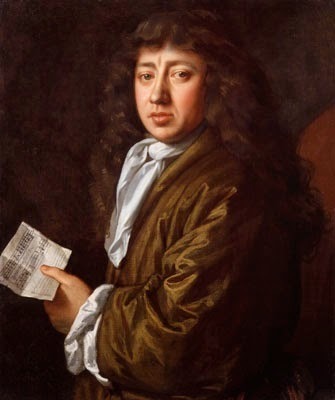 Samuel Pepys, famed diarist -
Samuel Pepys, famed diarist -
recording everyday life in the second half of the 17th century.When Pepys casually mentions drinking a pint of wine in the same sentence as the thaw and the pub, it makes me smile. Apparently, Pepys didn't think imbibing such a quantity of alcohol was anything out of the ordinary, which arguably it wasn't.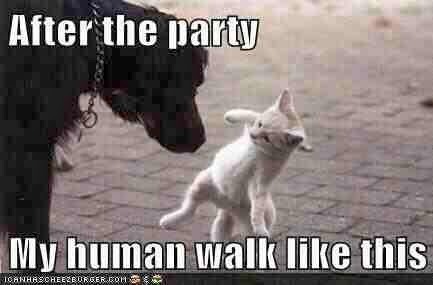
In the modern age the majority of people reading this post will have access to clean, sanitised drinking water - but this wasn't the case in the 17th century world. Although germ theory (disease is caused by micro-organisms) wasn't discovered until the late 19th century, instinct must have warned people that drinking dirty water led to awful stomach upsets. As such, alcohol was consumed more widely, by everyone from children and servants, to labourers and royalty, and perceived as being safer to drink than water. Cheapside in Victorian times - a couple of centuries after Pepys' dayEven though people didn't understand why, they perhaps recognised the result that the brewing process made water safer to drink. Of course we now know that boiling water, fermenting and the alcohol itself have disinfectant properties on some water-borne bugs.
Cheapside in Victorian times - a couple of centuries after Pepys' dayEven though people didn't understand why, they perhaps recognised the result that the brewing process made water safer to drink. Of course we now know that boiling water, fermenting and the alcohol itself have disinfectant properties on some water-borne bugs.
Was the Population Permanently Drunk?Possibly! However, 17th century alcohol wasn't as strong as the modern equivalent. One reason for this was that the yeasts weren't as hardy as our modern varieties, and less tolerant of the alcohol produced during fermentation. This meant that the brews were naturally limited in strength, because once they reached a certain level of alcohol, the yeast died and the process stopped. Incidentally, these yeasts made for a cloudy drink, rather than the clear ales and wines of today, but the cloudiness was disguised by metal tankards or frosted glass.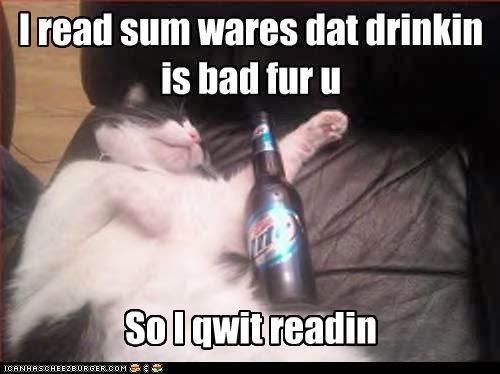
As an aside, the small beer or wine produced was much sweeter than modern brews. Again, this was because the yeast died before all the sugar was converted to alcohol. Also, it is interesting to reflect that grain stores were vulnerable to spoilage by rodents -so the safest way to protect your harvest was to convert it to beer, which preserved the sugar and calorie content! (Don't forget, sugar was hideously expensive commodity.)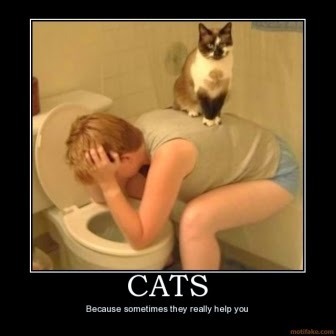 Apologies - couldn't resist this one! So was the population permanently drunk? Perhaps. But one knock on effect for Pepys could be that the quantity of alcohol he consumed contributed to the formation of his bladder stones.
Apologies - couldn't resist this one! So was the population permanently drunk? Perhaps. But one knock on effect for Pepys could be that the quantity of alcohol he consumed contributed to the formation of his bladder stones.
And finally:In this excerpt we learn that Pepys drank at the Star in Cheapside. Amongst the general population literacy rates were low and people liked places that were easily identifiable with a picture. Hence pubs, such as the Star, Bull or Bell, denoted with a painting on their sign were popular.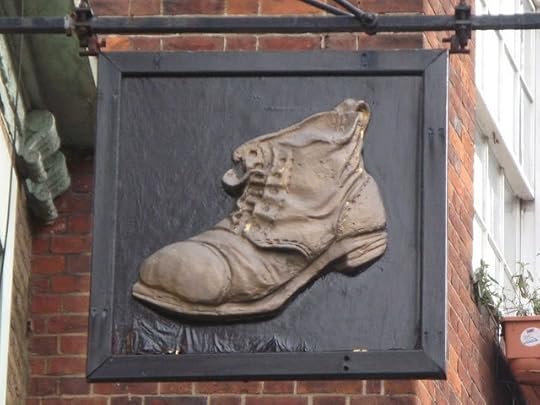 Pub signs, such as this one for 'The Boot' were pictorial
Pub signs, such as this one for 'The Boot' were pictorial
at a time when literacy rates were low.
 Samuel Pepys, famed diarist -
Samuel Pepys, famed diarist -recording everyday life in the second half of the 17th century.When Pepys casually mentions drinking a pint of wine in the same sentence as the thaw and the pub, it makes me smile. Apparently, Pepys didn't think imbibing such a quantity of alcohol was anything out of the ordinary, which arguably it wasn't.

In the modern age the majority of people reading this post will have access to clean, sanitised drinking water - but this wasn't the case in the 17th century world. Although germ theory (disease is caused by micro-organisms) wasn't discovered until the late 19th century, instinct must have warned people that drinking dirty water led to awful stomach upsets. As such, alcohol was consumed more widely, by everyone from children and servants, to labourers and royalty, and perceived as being safer to drink than water.
 Cheapside in Victorian times - a couple of centuries after Pepys' dayEven though people didn't understand why, they perhaps recognised the result that the brewing process made water safer to drink. Of course we now know that boiling water, fermenting and the alcohol itself have disinfectant properties on some water-borne bugs.
Cheapside in Victorian times - a couple of centuries after Pepys' dayEven though people didn't understand why, they perhaps recognised the result that the brewing process made water safer to drink. Of course we now know that boiling water, fermenting and the alcohol itself have disinfectant properties on some water-borne bugs.Was the Population Permanently Drunk?Possibly! However, 17th century alcohol wasn't as strong as the modern equivalent. One reason for this was that the yeasts weren't as hardy as our modern varieties, and less tolerant of the alcohol produced during fermentation. This meant that the brews were naturally limited in strength, because once they reached a certain level of alcohol, the yeast died and the process stopped. Incidentally, these yeasts made for a cloudy drink, rather than the clear ales and wines of today, but the cloudiness was disguised by metal tankards or frosted glass.

As an aside, the small beer or wine produced was much sweeter than modern brews. Again, this was because the yeast died before all the sugar was converted to alcohol. Also, it is interesting to reflect that grain stores were vulnerable to spoilage by rodents -so the safest way to protect your harvest was to convert it to beer, which preserved the sugar and calorie content! (Don't forget, sugar was hideously expensive commodity.)
 Apologies - couldn't resist this one! So was the population permanently drunk? Perhaps. But one knock on effect for Pepys could be that the quantity of alcohol he consumed contributed to the formation of his bladder stones.
Apologies - couldn't resist this one! So was the population permanently drunk? Perhaps. But one knock on effect for Pepys could be that the quantity of alcohol he consumed contributed to the formation of his bladder stones.And finally:In this excerpt we learn that Pepys drank at the Star in Cheapside. Amongst the general population literacy rates were low and people liked places that were easily identifiable with a picture. Hence pubs, such as the Star, Bull or Bell, denoted with a painting on their sign were popular.
 Pub signs, such as this one for 'The Boot' were pictorial
Pub signs, such as this one for 'The Boot' were pictorialat a time when literacy rates were low.
Published on March 19, 2014 12:29
March 12, 2014
The Tudor Kitchen at Hampton Court Palace
In February I visited the rediscovered Chocolate Kitchen at Hampton Court Palace and whilst there, I took the opportunity to investigate HCP's magnificent Tudor kitchens.
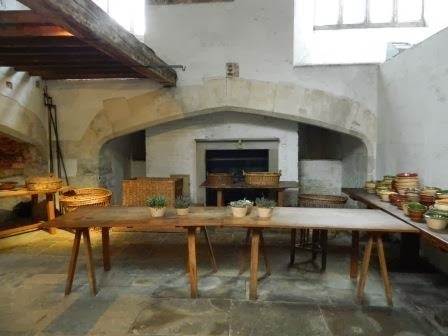
My current WIP (work in progress) is set in a Georgian kitchen (pssst, just for you - a sneak peek at the cover) and so I was keen to soak up the sounds, smells and sights of the kitchens at Hampton Court Palace.
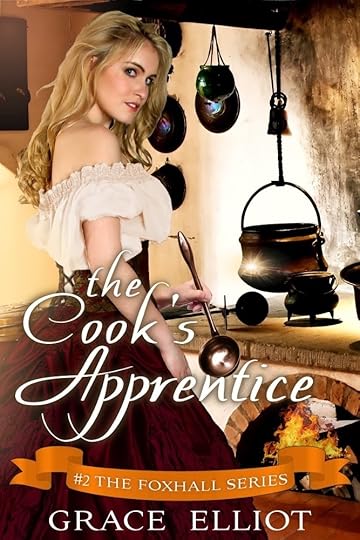 Due for release - summer 2014"The usual daily consumption is 80 - 100 sheep and the sheep are very big and fat - a dozen fat beef, a dozen and a half calves, without mentioning poultry, game, deer, boars and great numbers of rabbits."A Spanish visitor to the English Court, in 1554
Due for release - summer 2014"The usual daily consumption is 80 - 100 sheep and the sheep are very big and fat - a dozen fat beef, a dozen and a half calves, without mentioning poultry, game, deer, boars and great numbers of rabbits."A Spanish visitor to the English Court, in 1554
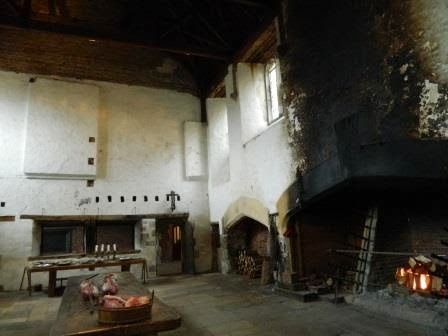
Hampton Court Palace is a place synonymous with King Henry VIII. When he held court there he was joined by a small army of courtiers who brought their servants with them - all of whom needed feeding. This involved storing and cooking huge amounts of meat, fish and vegetables, and each item of food was stored in a designated store: The Flesh Larder for meat, The Wet Larder for fish and the Dry Larder for less perishable goods. It was down to a kitchen staff of around 200 people to prepare the meals in the Great Kitchen and once cooked, the finished dishes were garnished in the Serving Place.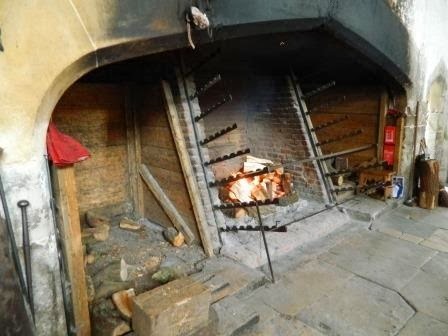
In 1526 around 600 courtiers were entitled to take their meals in the Great Hall or common dining room ( the King ate in his private apartments). Those of people of lower status such as general court servants, grooms and guards dined at 10am and 4pm, and the most senior man at the table served the food (a bit like doling out school dinners!)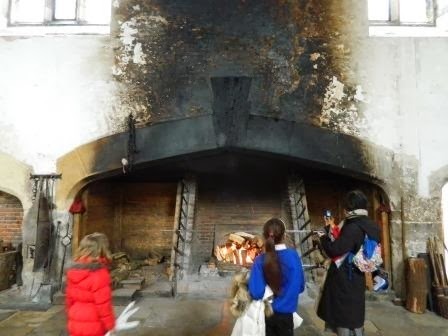
Higher status courtiers ate next door in the Great Watching Chamber, which was more akin to a restaurant with finer dishes and more variety. In addition, around 230 domestic servants were entitled to rations, but not allocated a place to eat and so most likely took their food to their work station or lodgings.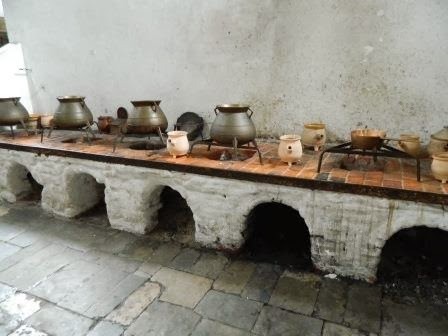
"God may send a man goode meate, but the devyll may sende an evylle cooke to dystrue it."Andrew Boorde (1490 - 1549)
As you can imagine to prepare such quantities of food took a lot of organisation. Indeed, food production was just that, a kind of factory like process. As an example take the making of a pie: pastry cooks made the case, butchers prepared the meat filling, which was then cook by the boiling house staff. The cases were then filled and baked in the pastry ovens and cooked, sent to the servery for garnishing then taken to the diners.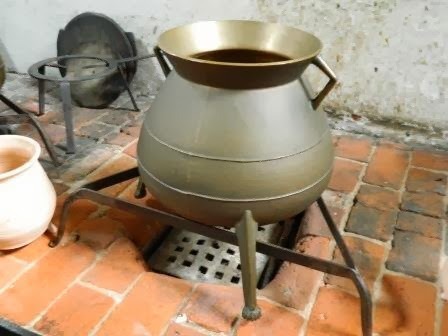
A large part of the diet was made up of meat, which was prepared in a variety of ways from roasting, boiling and stewing, to griddling (similar to barbecuing). Roasting was relatively expensive since it required a lot of fuel to heat the huge open fires, plus a man to turn the spit to make sure the meat cooked evenly.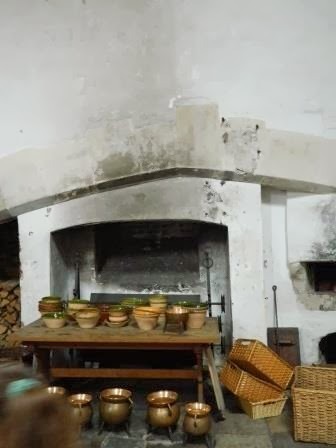 And finally, the food consumed needed to be washed down with something and this frequently took the form of beer. The average annual consumption of beer for the Tudor court was 600,000 gallons!
And finally, the food consumed needed to be washed down with something and this frequently took the form of beer. The average annual consumption of beer for the Tudor court was 600,000 gallons!

My current WIP (work in progress) is set in a Georgian kitchen (pssst, just for you - a sneak peek at the cover) and so I was keen to soak up the sounds, smells and sights of the kitchens at Hampton Court Palace.
 Due for release - summer 2014"The usual daily consumption is 80 - 100 sheep and the sheep are very big and fat - a dozen fat beef, a dozen and a half calves, without mentioning poultry, game, deer, boars and great numbers of rabbits."A Spanish visitor to the English Court, in 1554
Due for release - summer 2014"The usual daily consumption is 80 - 100 sheep and the sheep are very big and fat - a dozen fat beef, a dozen and a half calves, without mentioning poultry, game, deer, boars and great numbers of rabbits."A Spanish visitor to the English Court, in 1554

Hampton Court Palace is a place synonymous with King Henry VIII. When he held court there he was joined by a small army of courtiers who brought their servants with them - all of whom needed feeding. This involved storing and cooking huge amounts of meat, fish and vegetables, and each item of food was stored in a designated store: The Flesh Larder for meat, The Wet Larder for fish and the Dry Larder for less perishable goods. It was down to a kitchen staff of around 200 people to prepare the meals in the Great Kitchen and once cooked, the finished dishes were garnished in the Serving Place.

In 1526 around 600 courtiers were entitled to take their meals in the Great Hall or common dining room ( the King ate in his private apartments). Those of people of lower status such as general court servants, grooms and guards dined at 10am and 4pm, and the most senior man at the table served the food (a bit like doling out school dinners!)

Higher status courtiers ate next door in the Great Watching Chamber, which was more akin to a restaurant with finer dishes and more variety. In addition, around 230 domestic servants were entitled to rations, but not allocated a place to eat and so most likely took their food to their work station or lodgings.

"God may send a man goode meate, but the devyll may sende an evylle cooke to dystrue it."Andrew Boorde (1490 - 1549)
As you can imagine to prepare such quantities of food took a lot of organisation. Indeed, food production was just that, a kind of factory like process. As an example take the making of a pie: pastry cooks made the case, butchers prepared the meat filling, which was then cook by the boiling house staff. The cases were then filled and baked in the pastry ovens and cooked, sent to the servery for garnishing then taken to the diners.

A large part of the diet was made up of meat, which was prepared in a variety of ways from roasting, boiling and stewing, to griddling (similar to barbecuing). Roasting was relatively expensive since it required a lot of fuel to heat the huge open fires, plus a man to turn the spit to make sure the meat cooked evenly.
 And finally, the food consumed needed to be washed down with something and this frequently took the form of beer. The average annual consumption of beer for the Tudor court was 600,000 gallons!
And finally, the food consumed needed to be washed down with something and this frequently took the form of beer. The average annual consumption of beer for the Tudor court was 600,000 gallons!
Published on March 12, 2014 03:58
March 5, 2014
Turnspit Dogs : Every Dog has his Day
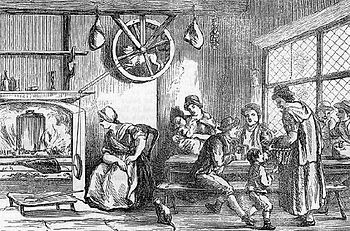 Note the dog in the wheel near the ceiling.“How well do I recollect, in the days of my youth, watching the operations of a turnspit at the house of a worthy old Welsh clergyman in Worcestershire, who taught me to read.”Anecdotes of Dogs, Edward Jesse, 1870
Note the dog in the wheel near the ceiling.“How well do I recollect, in the days of my youth, watching the operations of a turnspit at the house of a worthy old Welsh clergyman in Worcestershire, who taught me to read.”Anecdotes of Dogs, Edward Jesse, 1870
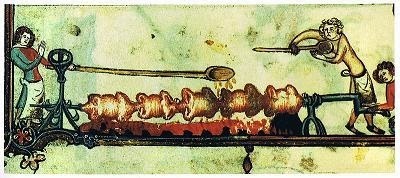 Before the use of dog-power, spits were laboriously turned by handThis week’s blog post is about the ‘Turnspit’ dog – a breed now extinct. It was the purpose of these dogs to run inside a wheel which in turn powered a spit used to roast meat. Prior to this automation roasting meats had to be turned by hand which was both labour intensive and unreliable. The invention of a dog-powered device was hailed as a great improvement.“A dog…by a small wheel, walking round it and making it turn in such a manner that no cook or servant could do it more cleverly.”Johannes Caius – 1576 – Royal physician and dog expert.
Before the use of dog-power, spits were laboriously turned by handThis week’s blog post is about the ‘Turnspit’ dog – a breed now extinct. It was the purpose of these dogs to run inside a wheel which in turn powered a spit used to roast meat. Prior to this automation roasting meats had to be turned by hand which was both labour intensive and unreliable. The invention of a dog-powered device was hailed as a great improvement.“A dog…by a small wheel, walking round it and making it turn in such a manner that no cook or servant could do it more cleverly.”Johannes Caius – 1576 – Royal physician and dog expert.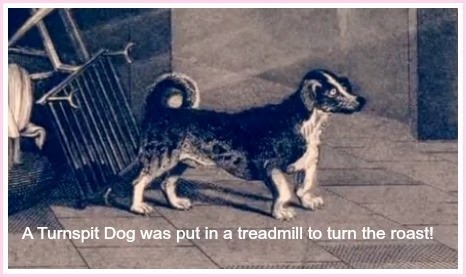
In the mid 1700’s Carolus Linnaeus mentions a breed of turnspit dog and later still, Charles Darwin mention their short legs as an example of genetic selection. Since the dogs had to work in a confined space short legs and heavy bodies gave them an advantage to turn the wheel. In France the breed were described as ‘Basset a jambs torses’ and pictures show a short-legged dog with a long heavy body somewhat similar to the modern Basset Griffon Vendeen. “The Turnspits are remarkable for their great length of body and short and usually crooked legs. Their colour is generally a dusky grey spotted with black or entirely black with the under parts whitish.”Bingley’s Memoirs of British Quadrupeds 1809
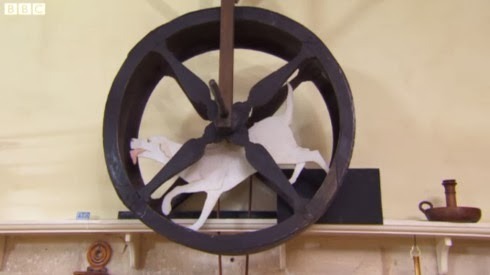 An example of a dog turnspit - From the White Hart Inn, Bath.The work was hard, hot and lacking in stimulation. Whereas other working breeds had the thrill of chasing rats or pointing out game, the Turnspit dog did his work out of compulsion and a likely scolding if he slacked in his task. “The poor animal…went about his employment like a caged mouse or squirrel with his recreation wheel…revolved in a treadwheel, which in this instance was connected with apparatus for turning the joints roasting at the fire and formed not so much recreation as extremely hard work.”Charles G Harper – The Old Inns of England - 1906
An example of a dog turnspit - From the White Hart Inn, Bath.The work was hard, hot and lacking in stimulation. Whereas other working breeds had the thrill of chasing rats or pointing out game, the Turnspit dog did his work out of compulsion and a likely scolding if he slacked in his task. “The poor animal…went about his employment like a caged mouse or squirrel with his recreation wheel…revolved in a treadwheel, which in this instance was connected with apparatus for turning the joints roasting at the fire and formed not so much recreation as extremely hard work.”Charles G Harper – The Old Inns of England - 1906
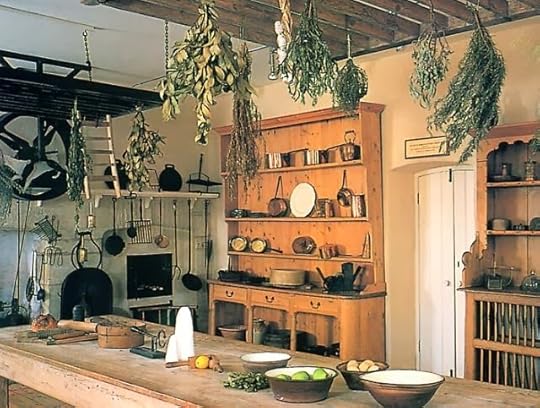 See the detail above (wheel in top left hand corner)Numerous stories exist of dogs evading their work, as mentioned by a Mr Wigstead, when writing about a pub in Newcastle where he observed:“Great care must be taken that this animal [the Turnspit dog] does not observe the cook approach the larder. If he does, he immediately hides himself for the remainder of the day.”
See the detail above (wheel in top left hand corner)Numerous stories exist of dogs evading their work, as mentioned by a Mr Wigstead, when writing about a pub in Newcastle where he observed:“Great care must be taken that this animal [the Turnspit dog] does not observe the cook approach the larder. If he does, he immediately hides himself for the remainder of the day.”In a large household where particularly heavy joints of meat were roasted, often two dogs were used, each alternating for a few hours in the wheel, or else worked on a ‘day-on-day-off’ basis. These animals soon became accustomed to this routine and if called upon to work on a day other than his usual, would hide away. Indeed, this regime is thought to be the origin of the phrase “each dog will have his day.”
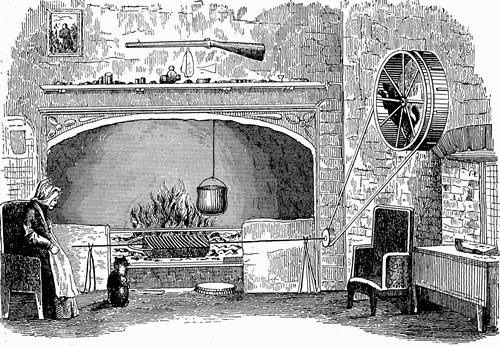
Whether as testament to a dog’s intelligence or the drudgery of the work, other stories are recorded, such as that told of the kitchen of the Duke de Liancourt who had two dog-powered turnspits, used alternately. One day the ‘working’ dog went missing and so his companion was forced to work two days in a row. At the end of his duty, by wagging and whining, the dog took the kitchen staff to where his lazy companion was hiding and flushed him out.
A similar tale exists of a cook who couldn’t find the dog whose turn it was to work the spit and so attempted to put his favourite dog in the wheel. This dog rebelled and ran into the garden, found the missing dog and drove him inside where the latter went of his own accord into the wheel.
'With eagerness he still does forward tend,
Like Sisyphus, whose journey has no end.'
- anonymous poem, Upon a dog called Fuddle, turnspit at the Popinjay, in Norwich
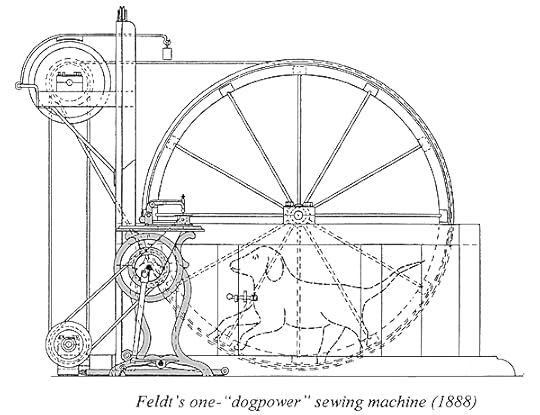 A prototype dog-powered sewing machine!Even when not working in the kitchen, Turnspit dogs were put to other purposes. An old story exists of some turnspit dogs from Bath, who on cold Sundays were taken to church to be used as foot warmers. However, on one occaision this backfired whilst the Bishop of Gloucester gave his sermon and sited the line “It was then that Ezekial saw the wheel…”. On hearing the word “wheel” the dogs ran off, associating it with work to be done!
A prototype dog-powered sewing machine!Even when not working in the kitchen, Turnspit dogs were put to other purposes. An old story exists of some turnspit dogs from Bath, who on cold Sundays were taken to church to be used as foot warmers. However, on one occaision this backfired whilst the Bishop of Gloucester gave his sermon and sited the line “It was then that Ezekial saw the wheel…”. On hearing the word “wheel” the dogs ran off, associating it with work to be done!However, not everyone was oblivious to the hard lot of the turnspit dog. In 1866, Henry Bergh, founder of the American Society for the Prevention of Cruelty to Animals, sited the dogs’ treatment as tantamount to slavery. He abhorred how the dogs were forced to trot for hours next to a blazing fire, with no access to water – and if they were tardy about their task the cook might even toss a hot coal onto the treadmill platform to enliven their paws.
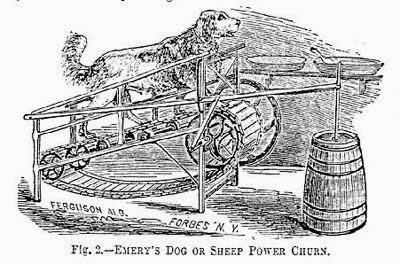 Dogs were used to power other devices - such as a butter churn.And finally, on a brighter note, in Robert Chambers 1869 “Book of Days” he recounts an anecdote about an 18th century ship’s captain. When the captain docked at Bristol he became angry with the locals over their lack of hospitality to his crew. In retribution, under cover of darknes he sent his men to steal all the town’s turnspit dogs. When the roast meat was all gone and the crisis became acute, the townsfolk apologized, opened their doors to the sailors and the dogs returned.
Dogs were used to power other devices - such as a butter churn.And finally, on a brighter note, in Robert Chambers 1869 “Book of Days” he recounts an anecdote about an 18th century ship’s captain. When the captain docked at Bristol he became angry with the locals over their lack of hospitality to his crew. In retribution, under cover of darknes he sent his men to steal all the town’s turnspit dogs. When the roast meat was all gone and the crisis became acute, the townsfolk apologized, opened their doors to the sailors and the dogs returned.
Published on March 05, 2014 02:30
February 26, 2014
The Georgian Chocolatier Grace Tosier - and some Historical Chocolate Trivia
Q – When was the first chocolate bar created? Was it: 1649, 1749, 1849 or 1949?Answer at the end of this post!
In last week’s post about the awesome chocolate kitchen at Hampton Court Palace, we were introduced to Thomas Tosier – chocolatier to King George I. But the story doesn’t end there as Thomas had an enterprising wife, Grace Tosier, who was something of a phenomena in her own rite.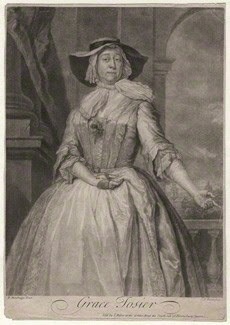 Grace Tosier with her trade mark wide brimmed hat and
Grace Tosier with her trade mark wide brimmed hat and
posy of flowers at her bosom.Grace seems a larger than life character. A portrait of her exists which shows a jolly looking woman wearing the trade mark large brimmed hat and a posy of flowers in her bosom. Whilst her husband worked for the king at Hampton Court Palace, she ran a successful chocolate house in Greenwich.In the 18th century chocolate houses were a bye word amongst the upper classes for luxury, sophistication and good company. Grace was canny enough to recognize that when it came to cocoa and Tosier’s links to the king, their surname was a brand to be reckoned with. Indeed, when her husband died and eventually she remarried, she valued it enough to retain the name Grace Tosier.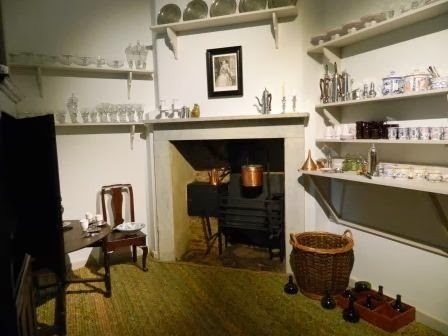 The chocolate kitchen at Hampton Court Palace -
The chocolate kitchen at Hampton Court Palace -
it was here that the actual cup of hot chocolate was created.Grace’s story is interwoven with the history of chocolate. Historically, the invention of chocolate bars is relatively recent, and for two thousand years cocoa was consumed as a beverage. The practice first took place in Mexico, when the court of Montezuma, king of the Aztecs, consumed a post-prandial chalice of chocolate which was decanted from one vessel to another until it gained a frothy head.To create the beverage the sun-dried, roasted in earthen pots, the shells removed and the kernels ground over a fire. The heat turned the powder to a paste, the flavouring added and the mix formed into cakes which was left on banana leaves to dry ready for storage. To make the drinking chocolate the cakes were crumbled into water, heated and whipped up.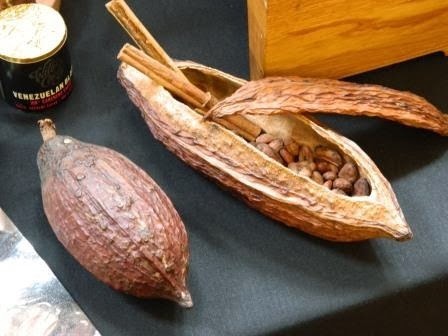 Cocoa pods and beans.
Cocoa pods and beans.
The cocoa harvest was considered unreliable and so the plants
were grown beneath banana trees for a second revenue stream.The Aztecs gave chocolate to warriors in blocks coloured with annatto, a red dye, which stained the lips and tongue in symbolism of human blood (the Aztecs and Mayans had a penchant for human sacrifice!)“The lips and part of the face around them, are covered with the foam, and when it has been coloured with annatoo it looks horrific because it is just like blood.” Gonzalez de Oviedo, writing in the 16th century. For a long period the Spanish kept hot chocolate secret with such success that when in 1579 British buccaneers stopped a Spanish ship, they tipped the cargo of cocoa beans overboard as worthless. But by 1660 the Europeans had cottoned on to what they were missing and drinking chocolate became hugely popular. Books of recipes appeared as early as 1609, as people experimented with ideas such as replacing cornmeal as a thickener, with ground almonds. The Aztec frothiness was mimicked by using a special swizzle stick, or molinillo, and indeed later chocolate pots can be told apart from coffee pots by the hole in the lid through which the molinillo was inserted.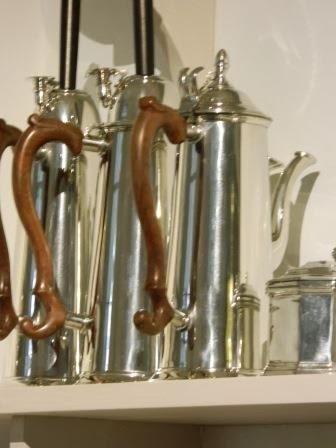 Hot chocolate pots on display at the chocolate
Hot chocolate pots on display at the chocolate
kitchens at Hampton Court PalaceIn the mid 17th century via a succession of royal marriages chocolate drinking crossed through Spain, Portugal, Italy, France on its way to England. The drink was sold in chocolate shops which were an environment for the wealthy to discuss business and some gained reputations for being breeding grounds for radical politics. In 1675 King Charles II felt so threatened by the hotbed of chocolate houses that for a short time he closed them down. One can imagine the uproar of the public being deprived of chocolate – and they soon reopened.
And finally, the answer to the teaser question:Q – When was the first chocolate bar created? Was it: 1649, 1749, 1849 or 1949?Answer at the end of this post!
A – 1849 The first chocolate bars were not announced with a fanfare, but created as a means of using up waste products left over from the manufacture of cocoa powder for hot chocolate drinks.
In last week’s post about the awesome chocolate kitchen at Hampton Court Palace, we were introduced to Thomas Tosier – chocolatier to King George I. But the story doesn’t end there as Thomas had an enterprising wife, Grace Tosier, who was something of a phenomena in her own rite.
 Grace Tosier with her trade mark wide brimmed hat and
Grace Tosier with her trade mark wide brimmed hat andposy of flowers at her bosom.Grace seems a larger than life character. A portrait of her exists which shows a jolly looking woman wearing the trade mark large brimmed hat and a posy of flowers in her bosom. Whilst her husband worked for the king at Hampton Court Palace, she ran a successful chocolate house in Greenwich.In the 18th century chocolate houses were a bye word amongst the upper classes for luxury, sophistication and good company. Grace was canny enough to recognize that when it came to cocoa and Tosier’s links to the king, their surname was a brand to be reckoned with. Indeed, when her husband died and eventually she remarried, she valued it enough to retain the name Grace Tosier.
 The chocolate kitchen at Hampton Court Palace -
The chocolate kitchen at Hampton Court Palace -it was here that the actual cup of hot chocolate was created.Grace’s story is interwoven with the history of chocolate. Historically, the invention of chocolate bars is relatively recent, and for two thousand years cocoa was consumed as a beverage. The practice first took place in Mexico, when the court of Montezuma, king of the Aztecs, consumed a post-prandial chalice of chocolate which was decanted from one vessel to another until it gained a frothy head.To create the beverage the sun-dried, roasted in earthen pots, the shells removed and the kernels ground over a fire. The heat turned the powder to a paste, the flavouring added and the mix formed into cakes which was left on banana leaves to dry ready for storage. To make the drinking chocolate the cakes were crumbled into water, heated and whipped up.
 Cocoa pods and beans.
Cocoa pods and beans.The cocoa harvest was considered unreliable and so the plants
were grown beneath banana trees for a second revenue stream.The Aztecs gave chocolate to warriors in blocks coloured with annatto, a red dye, which stained the lips and tongue in symbolism of human blood (the Aztecs and Mayans had a penchant for human sacrifice!)“The lips and part of the face around them, are covered with the foam, and when it has been coloured with annatoo it looks horrific because it is just like blood.” Gonzalez de Oviedo, writing in the 16th century. For a long period the Spanish kept hot chocolate secret with such success that when in 1579 British buccaneers stopped a Spanish ship, they tipped the cargo of cocoa beans overboard as worthless. But by 1660 the Europeans had cottoned on to what they were missing and drinking chocolate became hugely popular. Books of recipes appeared as early as 1609, as people experimented with ideas such as replacing cornmeal as a thickener, with ground almonds. The Aztec frothiness was mimicked by using a special swizzle stick, or molinillo, and indeed later chocolate pots can be told apart from coffee pots by the hole in the lid through which the molinillo was inserted.
 Hot chocolate pots on display at the chocolate
Hot chocolate pots on display at the chocolatekitchens at Hampton Court PalaceIn the mid 17th century via a succession of royal marriages chocolate drinking crossed through Spain, Portugal, Italy, France on its way to England. The drink was sold in chocolate shops which were an environment for the wealthy to discuss business and some gained reputations for being breeding grounds for radical politics. In 1675 King Charles II felt so threatened by the hotbed of chocolate houses that for a short time he closed them down. One can imagine the uproar of the public being deprived of chocolate – and they soon reopened.

And finally, the answer to the teaser question:Q – When was the first chocolate bar created? Was it: 1649, 1749, 1849 or 1949?Answer at the end of this post!
A – 1849 The first chocolate bars were not announced with a fanfare, but created as a means of using up waste products left over from the manufacture of cocoa powder for hot chocolate drinks.
Published on February 26, 2014 02:58
February 18, 2014
King George, the Chocolatier and Hampton Court Palace
Last week, I was privileged to preview the rediscovered ‘Chocolate Kitchen’ at Hampton Court Palace. On a blustery, wet day my twin loves of history and chocolate fused (if there’d been a cat padding round - utter perfection!)
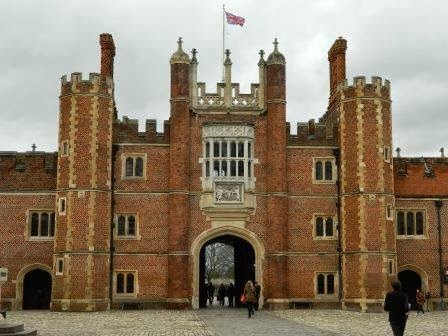 A blustery day at Hampton Court PalaceThe story behind the rooms is that of a king who loved hot chocolate. Out of his own purse (rather than the publicly funded privy purse), King George I employed a personal chocolatier, Thomas Tosier. It was Tosier’s job to roast and grind the cocoa beans, mix them into the rich spicy blend and serve it to his king.
A blustery day at Hampton Court PalaceThe story behind the rooms is that of a king who loved hot chocolate. Out of his own purse (rather than the publicly funded privy purse), King George I employed a personal chocolatier, Thomas Tosier. It was Tosier’s job to roast and grind the cocoa beans, mix them into the rich spicy blend and serve it to his king.
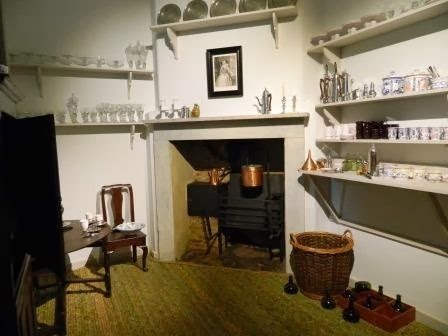 The room where the actual cup of cocoa would be prepared.
The room where the actual cup of cocoa would be prepared.In recent times used as a storeroom and now restored to its Georgian function.Way before the days of instant hot chocolate, to create the perfect cup of cocoa cost a small fortune and was a hallmark of wealth and opulence. The expenses incurred by the royal household paid for out of the Privy Purse were well documented, but because Tosier was a private employee, no such records existed. It was therefore a matter of detective work for the HistoricRoyal Palaces (HRP) restoration team to discover the location of Tosier’s kitchens.
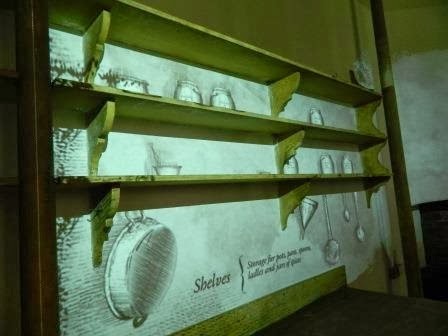 The room where the beans were roastedThe rooms were eventually located in the Baroque part of the palace, the Fountain Court. This is a short walk away from the main Tudor kitchen, which prevented the precious cocoa beans from being tainted by the smell of meat and fish. In all, there are three chocolate rooms. The first for roasting and preparing the beans, has a rare Georgian folding table, original shelving, a smoke jack for roasting and charcoal ovens. The second room contains the equipment and spices for grinding and blending. The third kitchen was where the final cup of cocoa would be created, complete with authentic reproductions of Georgian cocoa cups.
The room where the beans were roastedThe rooms were eventually located in the Baroque part of the palace, the Fountain Court. This is a short walk away from the main Tudor kitchen, which prevented the precious cocoa beans from being tainted by the smell of meat and fish. In all, there are three chocolate rooms. The first for roasting and preparing the beans, has a rare Georgian folding table, original shelving, a smoke jack for roasting and charcoal ovens. The second room contains the equipment and spices for grinding and blending. The third kitchen was where the final cup of cocoa would be created, complete with authentic reproductions of Georgian cocoa cups.
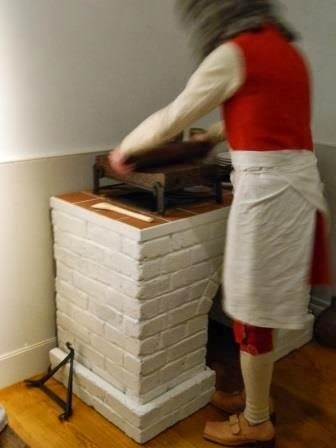 Beans being ground over on a granite slab
Beans being ground over on a granite slabover a low heat.Tosier’s famous skill came from knowing if the finer he ground the beans, the more flavor was released. He used a saddle shaped granite slab with a low heat beneath, and a granite rolling pin, to grind the beans. Then he added spices such as grains of paradise, chilies, aniseed and all spice, to create the flavor favored by the king. Georgian hot chocolate was less sweet, and spicier than the modern palate is accustomed to.
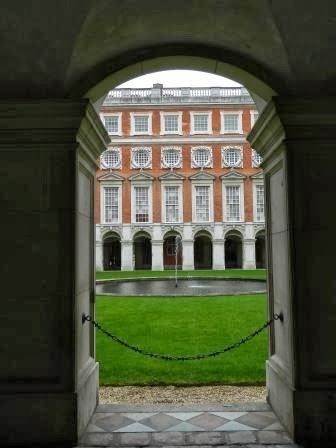 The Fountain Court -
The Fountain Court -away from the smell of the busy main kitchens.Indeed, the modern visitor can use all of his/her senses and taste hot chocolate through the ages (Stuart, Georgian, Victorian and modern) by purchasing a tasting platter at the café. [As a chocoholic myself, I was surprised at how much I preferred the Stuart cocoa – with its chilli, pepper and cardamom taste – compared to the more familiar Victorian flavor that was sickly sweet to say the least.]
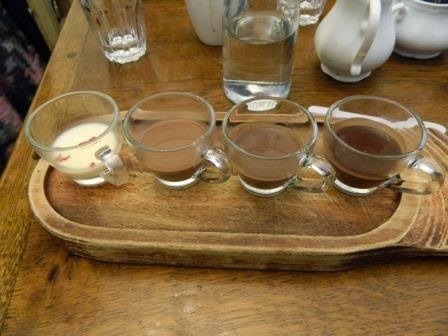 The hot chocolate tasting platter.
The hot chocolate tasting platter.From left to right:
Modern, Victorian, Georgian and Stuart cocoas.Hampton Court Palace is hugely evocative of Tudor history, but with opening of the Georgian Tudor chocolate kitchen a new dimension has been added. In contrast to the pies and meat associated with the impressive Tudor kitchens (worth a visit in their own right), the visitor glimpses the sophistication and opulence of the 18th century. The opening of the ChocolateKitchen is part of a wider celebration of the Georgians taking place across the Historic Royal Palaces in 2014 – to mark the 300th anniversary of George I’s Accession to the British throne. Many thanks to the lovely people at the Historic RoyalPalaces for giving me the opportunity to preview the kitchens.
Next week’s post is a more personal look at Thomas Tosier and his wife, Grace.
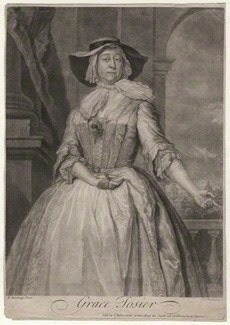 Grace Tosier - wife of Thomas
Grace Tosier - wife of ThomasMore of her next week.
Published on February 18, 2014 00:00
February 12, 2014
Of Rats, Rat-Catchers ... and Beatrix Potter!
“The large grey rats, having superior bodily powers…”Charles Fothergill 1813
This week’s post is on the unsavoury topic of rats – or more precisely, rat-catching. More significant than just scaring gentlewomen and spoiling food in larders, rats could do immense damage to crops in the field. And if the corn was destroy the price of grain (and thus, bread) rose, leaving the common man either hungry or broke.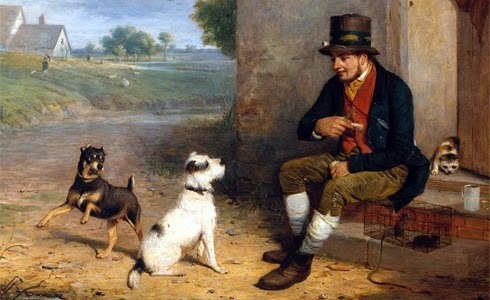 A rat-catcher with his dogs.In the past with mice and rats a part of everyday life, an animal that was good at killing such vermin was much prized. Cats are perhaps more traditionally associated with catching rodents, but this is not exclusively feline territory with terriers and some famous rat-catching dogs excelling at this skill as we find out later in this post.In the early 19thcentury Charles Fothergill attempted to work out how many rats were rampant in London. He estimated that a breeding pair of rats could produce three million young during their three year lifespan and his nightmarish vision predicted:“The whole surface of the earth in a very few years would be rendered a barren and hideous waste, covered with myriads of famished grey rats, against which man himself would contend in vain.”
A rat-catcher with his dogs.In the past with mice and rats a part of everyday life, an animal that was good at killing such vermin was much prized. Cats are perhaps more traditionally associated with catching rodents, but this is not exclusively feline territory with terriers and some famous rat-catching dogs excelling at this skill as we find out later in this post.In the early 19thcentury Charles Fothergill attempted to work out how many rats were rampant in London. He estimated that a breeding pair of rats could produce three million young during their three year lifespan and his nightmarish vision predicted:“The whole surface of the earth in a very few years would be rendered a barren and hideous waste, covered with myriads of famished grey rats, against which man himself would contend in vain.”
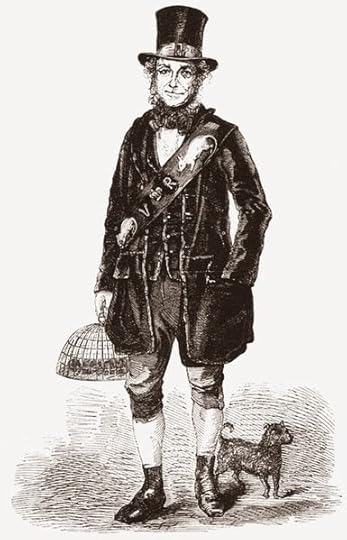 Jack BlackTo counter balance this scenario an efficient rat-killer could destroy around 8,000 rats a year. One such famous rat-catcher was a colourful character called Jack Black. He was well known in Victorian London from both his antics and self-made uniform of a scarlet topcoat, waistcoat and breeches, with a wide leather belt inset with iron rats. A record of his work has come down to us as he was interviewed by the Victorian chronicler of London life, Henry Mayhew. It seems as a young boy Black enjoyed showed off his rat-handling skills in Regents Park. “I wasn’t afraid to handle rats even then. It seem to come nat’ral to me. I very soon had some in my pocket, and some in my hands…I didn’t know the bites were so many, or I dare say I shouldn’t have been so venturesome as I was.”
Jack BlackTo counter balance this scenario an efficient rat-killer could destroy around 8,000 rats a year. One such famous rat-catcher was a colourful character called Jack Black. He was well known in Victorian London from both his antics and self-made uniform of a scarlet topcoat, waistcoat and breeches, with a wide leather belt inset with iron rats. A record of his work has come down to us as he was interviewed by the Victorian chronicler of London life, Henry Mayhew. It seems as a young boy Black enjoyed showed off his rat-handling skills in Regents Park. “I wasn’t afraid to handle rats even then. It seem to come nat’ral to me. I very soon had some in my pocket, and some in my hands…I didn’t know the bites were so many, or I dare say I shouldn’t have been so venturesome as I was.”
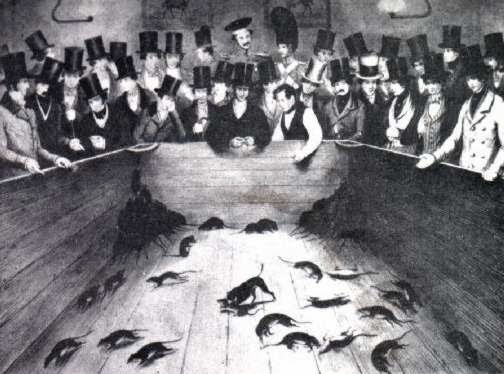 Rat BaitingHowever, Black’s motives for catching rats may not just have been to rid people of an infestation, because he also had a profitable side line in selling live rats to rat-baiting dens. This was a popular pastime (I hesitate to say ‘sport’) in London taverns where dog owners set their dog in a pit and bet on how many rats they could kill. One such dog was Bulldog-Billy. His claim to fame was killing a hundred rats in five-and-a-half minutes, during a contest at Cock Pit, Duck Lane, Westminster. Billy’s owner spotted a business opportunity and charged the princely sum of £10 per mating for the dog’s stud services. Indeed, such was Billy’s fame that in 1814 Princess Charlotte, the Prince Regent’s daughter, bred her three tricolor toy spaniels with him!
Rat BaitingHowever, Black’s motives for catching rats may not just have been to rid people of an infestation, because he also had a profitable side line in selling live rats to rat-baiting dens. This was a popular pastime (I hesitate to say ‘sport’) in London taverns where dog owners set their dog in a pit and bet on how many rats they could kill. One such dog was Bulldog-Billy. His claim to fame was killing a hundred rats in five-and-a-half minutes, during a contest at Cock Pit, Duck Lane, Westminster. Billy’s owner spotted a business opportunity and charged the princely sum of £10 per mating for the dog’s stud services. Indeed, such was Billy’s fame that in 1814 Princess Charlotte, the Prince Regent’s daughter, bred her three tricolor toy spaniels with him!
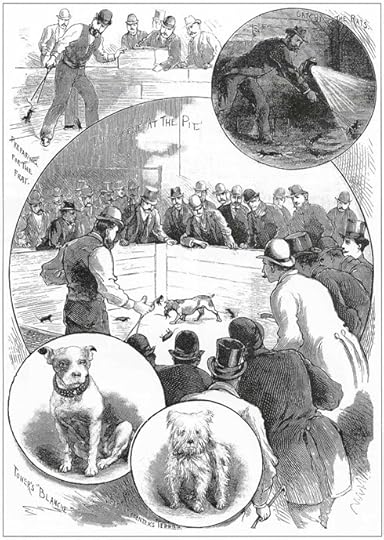 A New Jersey Rat PitThe trade of rat-catching could be potentially lucrative in more ways than one. Whilst ridding a house of rodents, Jack Black told Mayhew of a stash of silver he found in the cellar. “I found under on floor in a gent’s house a great quantity of table napkins and silver spoons and forks, which the rats had carried away for the grease on ‘em – shoes and boots gnawed to pieces, shifts, aprons, gowns, pieces of silk, and I don’t kow what not. Servants had been discharged, accused of stealing them there things. Of course I had to give them up; but there they was.”Black spotted the opportunity for making money from his best rat catching dogs. He had a black and tan terrier who was second to none and reportedly the father of most of the similar looking terriers in London. Black reports selling one of the dogs to the Austrian Ambassador, and he was offered a sovereign per pound of body weight for his dogs, which Black declined as too mean a price.
A New Jersey Rat PitThe trade of rat-catching could be potentially lucrative in more ways than one. Whilst ridding a house of rodents, Jack Black told Mayhew of a stash of silver he found in the cellar. “I found under on floor in a gent’s house a great quantity of table napkins and silver spoons and forks, which the rats had carried away for the grease on ‘em – shoes and boots gnawed to pieces, shifts, aprons, gowns, pieces of silk, and I don’t kow what not. Servants had been discharged, accused of stealing them there things. Of course I had to give them up; but there they was.”Black spotted the opportunity for making money from his best rat catching dogs. He had a black and tan terrier who was second to none and reportedly the father of most of the similar looking terriers in London. Black reports selling one of the dogs to the Austrian Ambassador, and he was offered a sovereign per pound of body weight for his dogs, which Black declined as too mean a price.
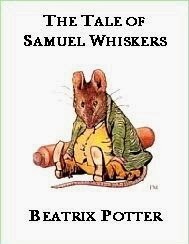
And finally, Black was very much poacher turned game-keeper as he was also partly responsible for establishing ‘fancy’ rats as pets. When he caught unusually coloured rats he bred them together to establish new colour varieties. He then sold these on as domesticated pets “To well-bred young ladies to keep in squirrel cages.” Beatrix Potter is reputedly one of his customers and dedicated her book Samuel Whiskers to her pet rat of the same name!
This week’s post is on the unsavoury topic of rats – or more precisely, rat-catching. More significant than just scaring gentlewomen and spoiling food in larders, rats could do immense damage to crops in the field. And if the corn was destroy the price of grain (and thus, bread) rose, leaving the common man either hungry or broke.
 A rat-catcher with his dogs.In the past with mice and rats a part of everyday life, an animal that was good at killing such vermin was much prized. Cats are perhaps more traditionally associated with catching rodents, but this is not exclusively feline territory with terriers and some famous rat-catching dogs excelling at this skill as we find out later in this post.In the early 19thcentury Charles Fothergill attempted to work out how many rats were rampant in London. He estimated that a breeding pair of rats could produce three million young during their three year lifespan and his nightmarish vision predicted:“The whole surface of the earth in a very few years would be rendered a barren and hideous waste, covered with myriads of famished grey rats, against which man himself would contend in vain.”
A rat-catcher with his dogs.In the past with mice and rats a part of everyday life, an animal that was good at killing such vermin was much prized. Cats are perhaps more traditionally associated with catching rodents, but this is not exclusively feline territory with terriers and some famous rat-catching dogs excelling at this skill as we find out later in this post.In the early 19thcentury Charles Fothergill attempted to work out how many rats were rampant in London. He estimated that a breeding pair of rats could produce three million young during their three year lifespan and his nightmarish vision predicted:“The whole surface of the earth in a very few years would be rendered a barren and hideous waste, covered with myriads of famished grey rats, against which man himself would contend in vain.”
 Jack BlackTo counter balance this scenario an efficient rat-killer could destroy around 8,000 rats a year. One such famous rat-catcher was a colourful character called Jack Black. He was well known in Victorian London from both his antics and self-made uniform of a scarlet topcoat, waistcoat and breeches, with a wide leather belt inset with iron rats. A record of his work has come down to us as he was interviewed by the Victorian chronicler of London life, Henry Mayhew. It seems as a young boy Black enjoyed showed off his rat-handling skills in Regents Park. “I wasn’t afraid to handle rats even then. It seem to come nat’ral to me. I very soon had some in my pocket, and some in my hands…I didn’t know the bites were so many, or I dare say I shouldn’t have been so venturesome as I was.”
Jack BlackTo counter balance this scenario an efficient rat-killer could destroy around 8,000 rats a year. One such famous rat-catcher was a colourful character called Jack Black. He was well known in Victorian London from both his antics and self-made uniform of a scarlet topcoat, waistcoat and breeches, with a wide leather belt inset with iron rats. A record of his work has come down to us as he was interviewed by the Victorian chronicler of London life, Henry Mayhew. It seems as a young boy Black enjoyed showed off his rat-handling skills in Regents Park. “I wasn’t afraid to handle rats even then. It seem to come nat’ral to me. I very soon had some in my pocket, and some in my hands…I didn’t know the bites were so many, or I dare say I shouldn’t have been so venturesome as I was.”
 Rat BaitingHowever, Black’s motives for catching rats may not just have been to rid people of an infestation, because he also had a profitable side line in selling live rats to rat-baiting dens. This was a popular pastime (I hesitate to say ‘sport’) in London taverns where dog owners set their dog in a pit and bet on how many rats they could kill. One such dog was Bulldog-Billy. His claim to fame was killing a hundred rats in five-and-a-half minutes, during a contest at Cock Pit, Duck Lane, Westminster. Billy’s owner spotted a business opportunity and charged the princely sum of £10 per mating for the dog’s stud services. Indeed, such was Billy’s fame that in 1814 Princess Charlotte, the Prince Regent’s daughter, bred her three tricolor toy spaniels with him!
Rat BaitingHowever, Black’s motives for catching rats may not just have been to rid people of an infestation, because he also had a profitable side line in selling live rats to rat-baiting dens. This was a popular pastime (I hesitate to say ‘sport’) in London taverns where dog owners set their dog in a pit and bet on how many rats they could kill. One such dog was Bulldog-Billy. His claim to fame was killing a hundred rats in five-and-a-half minutes, during a contest at Cock Pit, Duck Lane, Westminster. Billy’s owner spotted a business opportunity and charged the princely sum of £10 per mating for the dog’s stud services. Indeed, such was Billy’s fame that in 1814 Princess Charlotte, the Prince Regent’s daughter, bred her three tricolor toy spaniels with him!
 A New Jersey Rat PitThe trade of rat-catching could be potentially lucrative in more ways than one. Whilst ridding a house of rodents, Jack Black told Mayhew of a stash of silver he found in the cellar. “I found under on floor in a gent’s house a great quantity of table napkins and silver spoons and forks, which the rats had carried away for the grease on ‘em – shoes and boots gnawed to pieces, shifts, aprons, gowns, pieces of silk, and I don’t kow what not. Servants had been discharged, accused of stealing them there things. Of course I had to give them up; but there they was.”Black spotted the opportunity for making money from his best rat catching dogs. He had a black and tan terrier who was second to none and reportedly the father of most of the similar looking terriers in London. Black reports selling one of the dogs to the Austrian Ambassador, and he was offered a sovereign per pound of body weight for his dogs, which Black declined as too mean a price.
A New Jersey Rat PitThe trade of rat-catching could be potentially lucrative in more ways than one. Whilst ridding a house of rodents, Jack Black told Mayhew of a stash of silver he found in the cellar. “I found under on floor in a gent’s house a great quantity of table napkins and silver spoons and forks, which the rats had carried away for the grease on ‘em – shoes and boots gnawed to pieces, shifts, aprons, gowns, pieces of silk, and I don’t kow what not. Servants had been discharged, accused of stealing them there things. Of course I had to give them up; but there they was.”Black spotted the opportunity for making money from his best rat catching dogs. He had a black and tan terrier who was second to none and reportedly the father of most of the similar looking terriers in London. Black reports selling one of the dogs to the Austrian Ambassador, and he was offered a sovereign per pound of body weight for his dogs, which Black declined as too mean a price.

And finally, Black was very much poacher turned game-keeper as he was also partly responsible for establishing ‘fancy’ rats as pets. When he caught unusually coloured rats he bred them together to establish new colour varieties. He then sold these on as domesticated pets “To well-bred young ladies to keep in squirrel cages.” Beatrix Potter is reputedly one of his customers and dedicated her book Samuel Whiskers to her pet rat of the same name!
Published on February 12, 2014 08:25
February 5, 2014
Dog Collars - a Short History

This week’s blog post looks at dog collars through history. Dog collars are used restraint, to control and training purposed but from ancient times owners also used the opportunity to make a statement about their wealth or power.
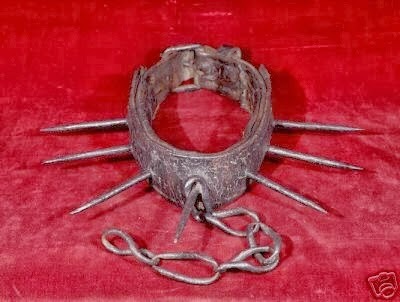
Medieval hunting dogs wore iron collars set with spikes which supposedly gave a measure of protection against a charging boar, and it did no harm that these aggressive looking collars reflected well on their master. Illustrations found in missals, Books of Hours and bestiaries suggest that dog collars were frequently made of precious metals and it was probably just as well that in medieval times dogs were a symbol of fidelity (you wouldn’t want your dog running off with a small fortune in gold round his neck.)
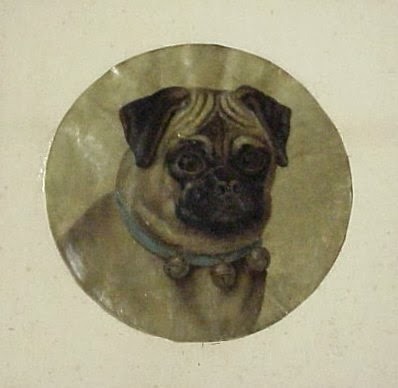 This pug wearing a bell collar dates from 1800
This pug wearing a bell collar dates from 1800and reflects the European fashion for bells.In the Far East a fashion for bells on collars dated back to the Tang Dynasty (618 – 907). In the 1720’s a Japanese Emperor owned a dog, Mao Shih Tzu, that wore a gold and silver collar bearing bells and earrings also with bells attached. The collar alerted the imperial servants to the Emperor’s movements as he moved around the palace. As trade with the far east opened up with the west, these collars with bells also became fashionable in Europe.
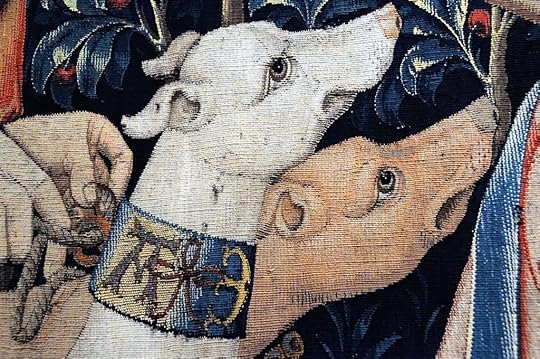 A detail from a tapestry showing a beautiful embroidered collar.Paintings serve as a rich source of information and since the wealthy mainly had their portraits painted, in this way we learn a lot about their dogs. Many paintings and tapestries show dogs in jewelled collars that boasted of their masters’ wealth. King Louis XI of France, had a collar of scarlet velvet sewn with pearls and rubies made for his favourite greyhound, Cherami. Inventories of the personal effects of another famous monarch, King Henry VIII, list many precious collars.“Two greyhound collars of crimson velvet and cloth of glod, lacking torrettes [spikes]”“Two other collars with the king’s armes and at the end portcullis and rose.”“A collar embroidered with pomegranates and roses with turrets of silver and gilt” [Catherine of Aragon’s symbol was a pomegranate] “A collar of garnished …with one shell of silver and guilt, with torrettes and pendauntes of silver and guilt.”
A detail from a tapestry showing a beautiful embroidered collar.Paintings serve as a rich source of information and since the wealthy mainly had their portraits painted, in this way we learn a lot about their dogs. Many paintings and tapestries show dogs in jewelled collars that boasted of their masters’ wealth. King Louis XI of France, had a collar of scarlet velvet sewn with pearls and rubies made for his favourite greyhound, Cherami. Inventories of the personal effects of another famous monarch, King Henry VIII, list many precious collars.“Two greyhound collars of crimson velvet and cloth of glod, lacking torrettes [spikes]”“Two other collars with the king’s armes and at the end portcullis and rose.”“A collar embroidered with pomegranates and roses with turrets of silver and gilt” [Catherine of Aragon’s symbol was a pomegranate] “A collar of garnished …with one shell of silver and guilt, with torrettes and pendauntes of silver and guilt.”
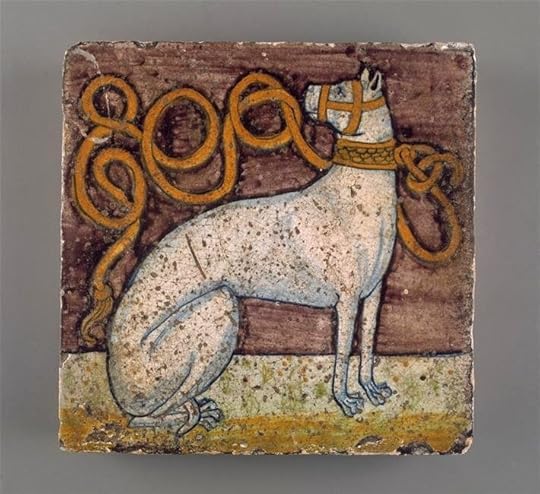
The colour of a collar could be an important mark of ownership, in much the same way that football strips are today. King Charles VIII’s household owned 24 pets and each wore a black velvet collar with four ermine paws dangling from them – the white part symbolised the Brittany coat of arms. The French king Charles IX owned 36 miniature greyhounds and they wore red and green velvet collars, whilst the dogs belonging to his sister-in-law, Mary Queen of Scots, wore blue velvet collars.Marie Antoinette’s dogs wore diamond encrusted collars but such extravagance vanished with the French Revolution and the pugs owned by Empress Josephine wore relatively simple collars decorated with Chinese bells.
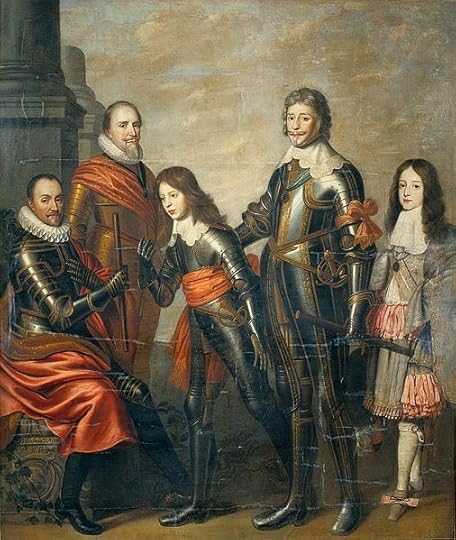 Four generations of the Dutch house of Orange-
Four generations of the Dutch house of Orange-showing their orange sashes.Pug dogs introduced to Holland as a result of Dutch trade in the Far East, during the 16th century wore orange ribbons around their necks as a sign of the ascendancy of the House of Orange. Whilst in the early 1720’s a Russian ambassador gave the Chinese envoy a pair of greyhounds, each wearing a yellow silk cord drawn through a small piece of wood, as a sign of it belonging to the Romanov court. Another fashion gained popularity in the late 17th century was for collars with inscriptions. In the English court the earliest engraving were fairly dull such as this one on a gilt copper collar line with red leather and blue velvet.“This dog belongs to his Royal Highness George Augustus, Prince of Wales, 1715.”A collar given by Alexander Pope to Frederick, Prince of Wales, for his Great Dane, was famously inscribed:“I am His Highness’ dog at KewPray, Tell me sir, whose dog are you.”And a silver dog collar reportedly worn by Bonnie Prince Charlie’s Italian Greyhound, was engraved with the Jacobite royal arms.
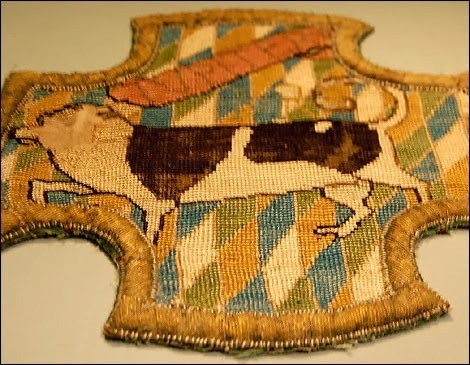 An embroidered patch showing 'Jupiter' one of Mary Queen of Scots
An embroidered patch showing 'Jupiter' one of Mary Queen of Scotsfavourite dogs.
And finally, from the leopard at the court of the Bavarian Duke, Albert, to Edward III’s kennel boys – it wasn’t just the dogs who wore dog collars…
Published on February 05, 2014 00:55
February 1, 2014
Release day news...The Ringmaster's Daughter
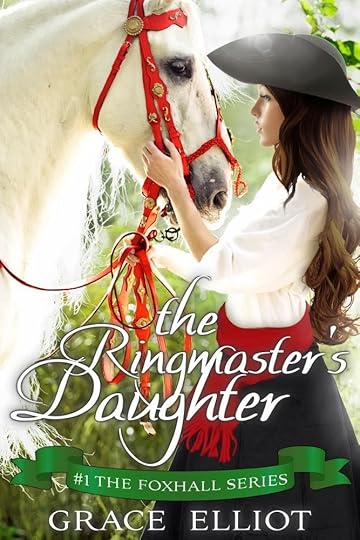 Now available!OUT NOW!
Now available!OUT NOW!Synopsis:
1770’s London The ringmaster’s daughter, Henrietta Hart, was born and raised around the stables of Foxhall Gardens. Now her father is gravely ill, and their livelihood in danger. The Harts' only hope is to convince Foxhall’s new manager, Mr Wolfson, to let Hetty wield the ringmaster’s whip. Hetty finds herself drawn to the arrogant Wolfson but, despite their mutual attraction, he gives her an ultimatum: entertain as never before – or leave Foxhall.When the winsome Hetty defies society and performs in breeches, Wolfson’s stony heart is in danger. Loath as he is to admit it, Hetty has a way with horses…and men. Her audacity and determination awaken emotions long since suppressed. But Hetty’s success in the ring threatens her future when she attracts the eye of the lascivious Lord Fordyce. The duke is determined, by fair means or foul, to possess Hetty as his mistress – and, as Wolfson’s feelings for Henrietta grow, disaster looms.
LAUNCH PARTY!! at 'virtual' Kensington Palace
You are cordially invited to join the celebration at the launch party for The Ringmaster's Daughter.
There are a ton of ebook to be given away from 8 authors of historical romance and historical fiction.
To join the party click here:
https://www.facebook.com/events/13746...
Saturday 1st February 1 - 6pm EST (6 - 11pm UK time)
Hope to see you there!
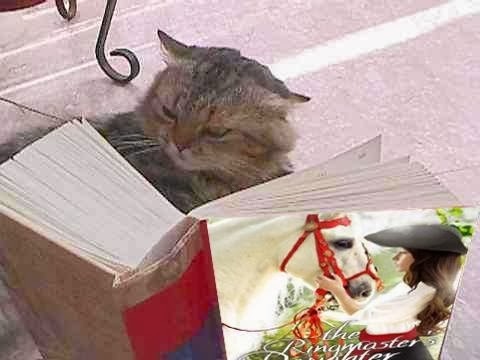 Just got to a juicy bit...http://www.amazon.com/dp/B00I2650GS
Just got to a juicy bit...http://www.amazon.com/dp/B00I2650GS
Published on February 01, 2014 09:36
January 29, 2014
Pug Dogs and Things Pugnacious
“Poor pug was caught, to town conveyed,There sold. How envied was his doom,Made captive in a lady’s room.”John Gay 1728
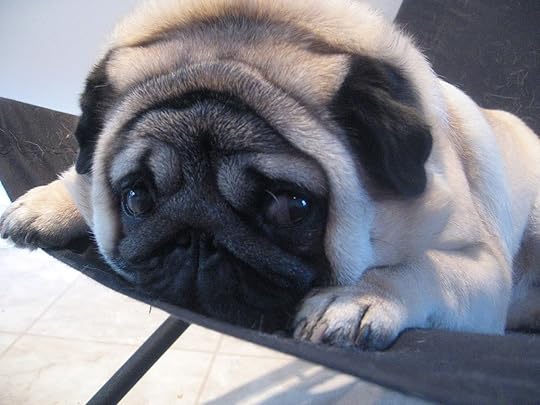
I have a confession to make. I’ve developed a fondness for pug dogs. This is unsettling for two reasons: Firstly, I’m obsessed with cats and secondly, breeding of dogs with ever shorter snouts is reprehensible and undoubtedly causes suffering – that said, they are rather cute!Pugs are an ancient breed and their roots can be traced back to China in 300 BC. However, their rise popularity in England can be dated quite precisely to 1688 with William of Orange bringing pugs with him to England from Holland. Prior to William’s accession to the throne, the dog most associated with the monarchy were the Stuart’s spaniels. Perhaps it suited the mood of the country to have a change of favourite dog along with the dynasty – but by the first half of the 18th century the breed was established as a favourite with the English aristocracy.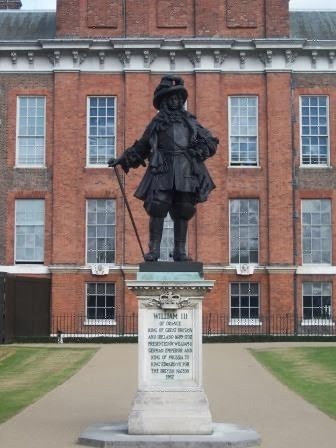 It was William III (seen here outside Kensington Palace)
It was William III (seen here outside Kensington Palace)
who was attributed with introducing pugs to EnglandThe association between the Netherlands and pugs is an ancient one but was solidified around 1573 when the then Prince of Orange was awoken by the scratching and crying of a pug, alerting the prince to a night attack by the Spanish and thus saving his life.“The Prince, to show his gratitude, until his dying day, kept one of that dog’s race…These animals were not remarkable for their beauty, being little white dogs, with crooked noses, called camuses [flat-nosed].” Sir Roger Williams writing in 1618.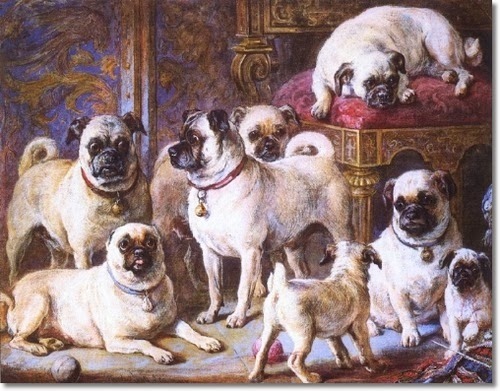 A portrait by Gourlat Steell (1867) of
A portrait by Gourlat Steell (1867) of
Queen Victoria's pugs. The dogs remained popular at the English court well into the 19th century, indeed during her lifetime Queen Victoria owned 36 pug dogs. In 1884 the queen also employed one belonging to Master John Strugnell to catch rats around the palace. Apparently afterwards, Mr Strugnell had a line added to his business card “Rat-catcher to Queen Victoria.”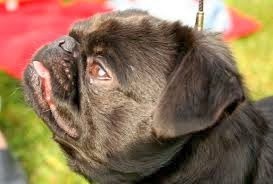 Compare the snout (or lack of!) with those depicted in the Steell portrait above.The pug was also a favourite of the French queen, Marie Antoinette. When in 1770 she married the future King Louis XIV, the morning after the wedding night the Dauphine was found rolling on the floor with a puppy. She missed her pug, Mops, and wanted the dog brought to Versailles from Vienna. However, the guardian of her moral welfare, the Abbe de Vermond, was a real kill joy and wrote to the Empress warning her that Marie Antoinette love of dogs and frivolity perplexed the Bourbon court. Such was the antagonism that her mother wrote in 1771, admonishing Marie Antoinette in these terms:“Such are the ties which attach you to them [pet dogs] in preference to your master….in the long run will make you an object of ridicule, neither loved nor esteemed.”Undeterred Marie Antoinette continued to walk along the terraces with her pet dogs, distracting the spaniels belonging to the Swiss Guard who were trained to scent out intruders.
Compare the snout (or lack of!) with those depicted in the Steell portrait above.The pug was also a favourite of the French queen, Marie Antoinette. When in 1770 she married the future King Louis XIV, the morning after the wedding night the Dauphine was found rolling on the floor with a puppy. She missed her pug, Mops, and wanted the dog brought to Versailles from Vienna. However, the guardian of her moral welfare, the Abbe de Vermond, was a real kill joy and wrote to the Empress warning her that Marie Antoinette love of dogs and frivolity perplexed the Bourbon court. Such was the antagonism that her mother wrote in 1771, admonishing Marie Antoinette in these terms:“Such are the ties which attach you to them [pet dogs] in preference to your master….in the long run will make you an object of ridicule, neither loved nor esteemed.”Undeterred Marie Antoinette continued to walk along the terraces with her pet dogs, distracting the spaniels belonging to the Swiss Guard who were trained to scent out intruders.
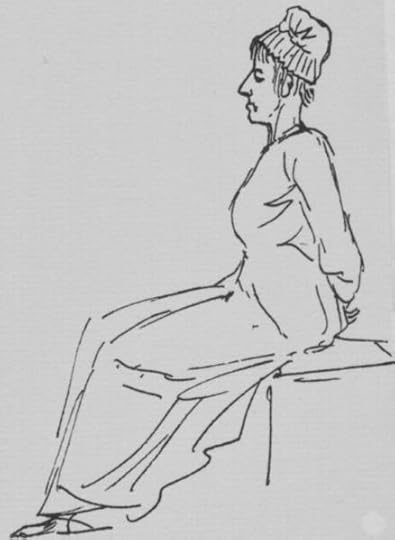 A sketch of Marie Antoinette on the way to
A sketch of Marie Antoinette on the way to
the guillotine in 16 October, 1793
In the last months of her life, whilst Marie Antoinette was imprisoned during the Terror, she had the comfort of a pug in her cell. After her execution, the man given in her cell, Monseighenur de Salamon, also benefited from the companionship of the same dog – albeit in an unusual way. He persuaded the jailer to open the door each morning and allow the dog in.“..This was the Queen’s dog…treated with the greatest care. The dog’s object in coming in…was to smell his mistress’s mattresses. I saw him behave in this way every morning at the same hour, for three whole months, and in spite of all my efforts I was never able to catch him.”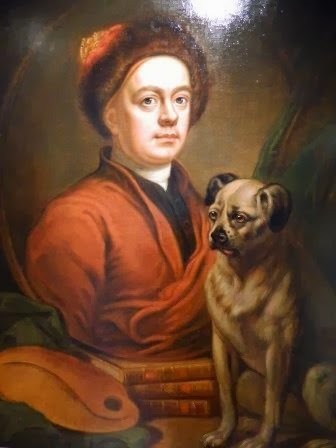 Self portrait - William Hogarth, with his dog, Trump.Another famous pug was Trump, the dog belonging to William Hogarth. Indeed, Hogarth likened both the dog’s looks and character to his own and included Trump in a self-portrait. From a veterinary point of view I find Trump’s picture interesting – you may note Trump has a distinct muzzle and nose, so much longer than the squash faced pugs of today. As mentioned at the beginning, the modern trend to breed dogs with ever flatter and more babyish faces, has led to BOAS or ‘brachycephalic airway obstruction syndrome’, a catalogue of deformities in the respiratory tract that mean the poor dogs struggle to breath. So, much as I’m falling in love with the delightful nature of most pugs, I won’t be encouraging breeders by buying one…
Self portrait - William Hogarth, with his dog, Trump.Another famous pug was Trump, the dog belonging to William Hogarth. Indeed, Hogarth likened both the dog’s looks and character to his own and included Trump in a self-portrait. From a veterinary point of view I find Trump’s picture interesting – you may note Trump has a distinct muzzle and nose, so much longer than the squash faced pugs of today. As mentioned at the beginning, the modern trend to breed dogs with ever flatter and more babyish faces, has led to BOAS or ‘brachycephalic airway obstruction syndrome’, a catalogue of deformities in the respiratory tract that mean the poor dogs struggle to breath. So, much as I’m falling in love with the delightful nature of most pugs, I won’t be encouraging breeders by buying one…
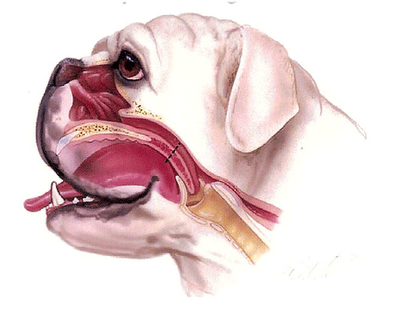 (French Bulldog - the anatomy similar to the pug)
(French Bulldog - the anatomy similar to the pug)
'Too much meat in the box'
The skull is the box and the tongue, soft palate and tonsils are the meat
Sadly, whilst the nose has shortened, the soft tissues remain the same size
which causes a serious obstruction at the back of the throat.

I have a confession to make. I’ve developed a fondness for pug dogs. This is unsettling for two reasons: Firstly, I’m obsessed with cats and secondly, breeding of dogs with ever shorter snouts is reprehensible and undoubtedly causes suffering – that said, they are rather cute!Pugs are an ancient breed and their roots can be traced back to China in 300 BC. However, their rise popularity in England can be dated quite precisely to 1688 with William of Orange bringing pugs with him to England from Holland. Prior to William’s accession to the throne, the dog most associated with the monarchy were the Stuart’s spaniels. Perhaps it suited the mood of the country to have a change of favourite dog along with the dynasty – but by the first half of the 18th century the breed was established as a favourite with the English aristocracy.
 It was William III (seen here outside Kensington Palace)
It was William III (seen here outside Kensington Palace)who was attributed with introducing pugs to EnglandThe association between the Netherlands and pugs is an ancient one but was solidified around 1573 when the then Prince of Orange was awoken by the scratching and crying of a pug, alerting the prince to a night attack by the Spanish and thus saving his life.“The Prince, to show his gratitude, until his dying day, kept one of that dog’s race…These animals were not remarkable for their beauty, being little white dogs, with crooked noses, called camuses [flat-nosed].” Sir Roger Williams writing in 1618.
 A portrait by Gourlat Steell (1867) of
A portrait by Gourlat Steell (1867) ofQueen Victoria's pugs. The dogs remained popular at the English court well into the 19th century, indeed during her lifetime Queen Victoria owned 36 pug dogs. In 1884 the queen also employed one belonging to Master John Strugnell to catch rats around the palace. Apparently afterwards, Mr Strugnell had a line added to his business card “Rat-catcher to Queen Victoria.”
 Compare the snout (or lack of!) with those depicted in the Steell portrait above.The pug was also a favourite of the French queen, Marie Antoinette. When in 1770 she married the future King Louis XIV, the morning after the wedding night the Dauphine was found rolling on the floor with a puppy. She missed her pug, Mops, and wanted the dog brought to Versailles from Vienna. However, the guardian of her moral welfare, the Abbe de Vermond, was a real kill joy and wrote to the Empress warning her that Marie Antoinette love of dogs and frivolity perplexed the Bourbon court. Such was the antagonism that her mother wrote in 1771, admonishing Marie Antoinette in these terms:“Such are the ties which attach you to them [pet dogs] in preference to your master….in the long run will make you an object of ridicule, neither loved nor esteemed.”Undeterred Marie Antoinette continued to walk along the terraces with her pet dogs, distracting the spaniels belonging to the Swiss Guard who were trained to scent out intruders.
Compare the snout (or lack of!) with those depicted in the Steell portrait above.The pug was also a favourite of the French queen, Marie Antoinette. When in 1770 she married the future King Louis XIV, the morning after the wedding night the Dauphine was found rolling on the floor with a puppy. She missed her pug, Mops, and wanted the dog brought to Versailles from Vienna. However, the guardian of her moral welfare, the Abbe de Vermond, was a real kill joy and wrote to the Empress warning her that Marie Antoinette love of dogs and frivolity perplexed the Bourbon court. Such was the antagonism that her mother wrote in 1771, admonishing Marie Antoinette in these terms:“Such are the ties which attach you to them [pet dogs] in preference to your master….in the long run will make you an object of ridicule, neither loved nor esteemed.”Undeterred Marie Antoinette continued to walk along the terraces with her pet dogs, distracting the spaniels belonging to the Swiss Guard who were trained to scent out intruders.
 A sketch of Marie Antoinette on the way to
A sketch of Marie Antoinette on the way tothe guillotine in 16 October, 1793
In the last months of her life, whilst Marie Antoinette was imprisoned during the Terror, she had the comfort of a pug in her cell. After her execution, the man given in her cell, Monseighenur de Salamon, also benefited from the companionship of the same dog – albeit in an unusual way. He persuaded the jailer to open the door each morning and allow the dog in.“..This was the Queen’s dog…treated with the greatest care. The dog’s object in coming in…was to smell his mistress’s mattresses. I saw him behave in this way every morning at the same hour, for three whole months, and in spite of all my efforts I was never able to catch him.”
 Self portrait - William Hogarth, with his dog, Trump.Another famous pug was Trump, the dog belonging to William Hogarth. Indeed, Hogarth likened both the dog’s looks and character to his own and included Trump in a self-portrait. From a veterinary point of view I find Trump’s picture interesting – you may note Trump has a distinct muzzle and nose, so much longer than the squash faced pugs of today. As mentioned at the beginning, the modern trend to breed dogs with ever flatter and more babyish faces, has led to BOAS or ‘brachycephalic airway obstruction syndrome’, a catalogue of deformities in the respiratory tract that mean the poor dogs struggle to breath. So, much as I’m falling in love with the delightful nature of most pugs, I won’t be encouraging breeders by buying one…
Self portrait - William Hogarth, with his dog, Trump.Another famous pug was Trump, the dog belonging to William Hogarth. Indeed, Hogarth likened both the dog’s looks and character to his own and included Trump in a self-portrait. From a veterinary point of view I find Trump’s picture interesting – you may note Trump has a distinct muzzle and nose, so much longer than the squash faced pugs of today. As mentioned at the beginning, the modern trend to breed dogs with ever flatter and more babyish faces, has led to BOAS or ‘brachycephalic airway obstruction syndrome’, a catalogue of deformities in the respiratory tract that mean the poor dogs struggle to breath. So, much as I’m falling in love with the delightful nature of most pugs, I won’t be encouraging breeders by buying one… (French Bulldog - the anatomy similar to the pug)
(French Bulldog - the anatomy similar to the pug)'Too much meat in the box'
The skull is the box and the tongue, soft palate and tonsils are the meat
Sadly, whilst the nose has shortened, the soft tissues remain the same size
which causes a serious obstruction at the back of the throat.
Published on January 29, 2014 02:34
'Familiar Felines.'
Following on from last weeks Halloween posting, today's blog post looks at the unwanted image of cats as the witches familiar - from the Norse Goddess Freya to lonely women in the middle ages.
The full Following on from last weeks Halloween posting, today's blog post looks at the unwanted image of cats as the witches familiar - from the Norse Goddess Freya to lonely women in the middle ages.
The full post can found at:
http://graceelliot-author.blogspot.com
...more
The full Following on from last weeks Halloween posting, today's blog post looks at the unwanted image of cats as the witches familiar - from the Norse Goddess Freya to lonely women in the middle ages.
The full post can found at:
http://graceelliot-author.blogspot.com
...more
- Grace Elliot's profile
- 156 followers



